If you would like a printed copy of any of our back issues, then they can be purchased on Farm Marketplace. You can also download the PDFs or read online from links below.
-
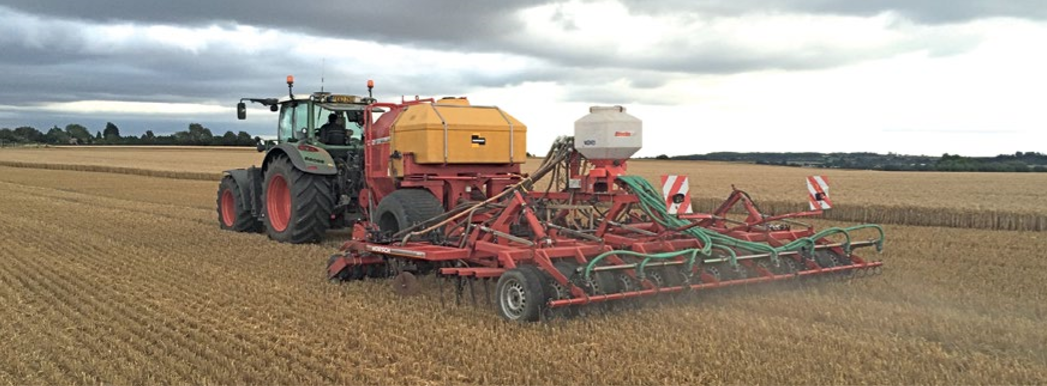
How To Start Drilling For £8K
Clive Bailye’s seed drill of choice is his 6m John Deere 750A , which has been used exclusively for 3-4 seasons. Last year, with an increased acreage, the founder and publisher of this Direct Driller magazine thought a second seed drill was necessary. Having just the one machine was a risk and in a difficult season would mean drilling was delayed. He looked around and found a good condition Horsch CO6 tine drill advertised in Germany.
Words and pictures by Mike Donovan
After delivery he rebuilt the coulters to a narrow profile so as to reduce soil disturbance. He says the tine drill is very useful driling after straw crops such as osr and also through the straw on second crop cereals.
Buying the drill from a German farmer was not particularly complicated, and provided him with a higher spec machine than Horsh sell in the UK. The seed dart tyres are much wider, and the machine is fitted with blockage monitors as well as full width front packers and also a liquid fert application system.
A sheaf of photos were taken, and Clive then asked for some of specific parts to show wear. The deal was done at under £5,000 which Clive says is the market value of these machines which are too large for small farmers to buy. Original owners like to buy new and sell when the machine is still in good condition.
Narrow tines with wear tiles
@Clive knew he wanted to make changes, substituting the Horsch tines and coulters for something far narrower, and has ended up getting his own design of tine made, which has a wear tile made from Ferobide, far harder than tungsten. The drill is on the farm primarily for osr and 2nd crop cereals drilled into chopped straw and the 25cm spacing is okay for these crops.
Comments on Clive’s on-line forum, TFF, said the drill many not be so good with beans, as the slot is a mere 12mm wide. And in barley the spacing may well be too wide as it needs to be thick. Clive points out that the seed pipe can actually be a bit wider than 12mm as it is in the shadow of the point. It would be good to have the option of using it for beans.

Above left: The cheap CO6 is being calibrated ready for its first outing

Above right: The adapted Horsch is being filled by the home built drill logistics trailer with seed and liquid starter fert.
Getting around the German instructions
The Horsch came, of course, with a control box and instructions in German. More on-line discussion revealed that English instructions were available on the Horsch website, and another explained that Horsch was sourcing some of these parts from Agton in Canada anyway. Zealman from New Zealand explained that the button marked with callipers should be held down for around 5 seconds. The menu is where you adjust the tramline sequence, valve layout and row numbers.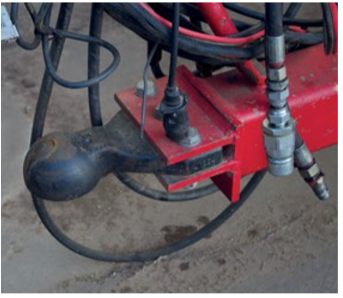
Ball hitch is a continental standard and provides a positive connection between tractor and drill

The Stocks Wizard has a rotor modified for Avadex which otherwise leaks everywhere
A Stocks Wizard is on the back of the drill and used for Avadex. Here again the knowledge of actual farmers is helpful. Alistair Nelson warned that the rotor and the surrounding shroud need to be changed, and he got good advice “from Rick at Stocks”. Clive has the same setup on the 750A and says that the Avadex leaks everywhere unless the modification is made. The drill was acquired and modified in 2016 and the results have been excellent.
The machine went through the residue without many problems and having the second drill has meant more timely planting. Clive has shown that moving into No-Till is not the expensive exercise so many farmers think it might be. The total cost, after modifications which included replacing all tines and coulters, was under £8,000.
Author Mike Donovan writes: we have featured a number of home made direct drills in @Practical Farm Ideas, and are always interested in seeing more. Please contact mike editor@farmideas.co.uk or 07778877514.
-
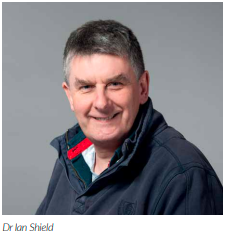
Farminn From Rothamsted
Dr Ian Shield, Rothamsted Research, explains how this venerable farming research institution is now working directly
with farmers to increase knowledge transferWhilst you’ve probably heard of Rothamsted, the world’s oldest agricultural research centre, it’s possible you won’t have dealt with us directly, or maybe even been aware of what impact we’ve had on the way you farm. However, thanks to a new citizen science initiative, that could all be about to change. Traditionally, the evidence we’ve produced has made its way into the farming community through indirect routes – either by influencing policy; through the best practice advice given out by agronomists and consultants; or via its impact on the wider agricultural industry.
Our founder, Sir John Bennet Lawes, formulated superphosphate, which marked the beginnings of the global chemical fertiliser industry. His LongTerm Field Experiments continue to this day, and at 176 years old, are the oldest, continuous agronomic experiments in the world. This has given us unique insights into soil and crop nutrition and today this expertise continues to manifest itself when our scientists contribute to the fertiliser manual (RB209). Ronald Fisher, the founding father of field experimental design and statistical analysis was a member of staff here, and his legacy can still be seen to this day in how we design and analyse experiments.

Research in recent years
In the 1970s Michael Elliott’s team discovered synthetic pyrethroid insecticides at Rothamsted and these now account for a quarter of all pest control agents used worldwide, whilst our insect survey has been providing regular bulletins on the current state of aphid and moth populations in your area and right across the UK, for more than 50 years. And last year our scientists helped to decode the wheat genome, and our Designing Future Wheat research is developing and screening novel germplasm for the next generation of wheat traits.
All this means we’ve probably influenced at least one aspect of the way you farm – even if you never realised it. Having been around for over 175 years, we’ve witnessed all sorts of changes – to farming and beyond. From how, why, and when we communicate; through upheaval in our national and local institutions; to an increase in the general scientific literacy of the population, society has evolved, and the old barriers that once separated the likes of Rothamsted from farmers up and down the country, are breaking down. Until recently, less than one percent of money spent on agricultural research was farmer led, but such research schemes are now increasing in popularity across the country – take for instance the Innovative Farmers scheme, the Yield Enhancement Network, and other similar initiatives.
The rise of these schemes comes from a growing realisation of the positive impact farmer led research can have. Our recent farmland earthworm surveys are great examples of such collaborative working, which in that case involved co-developing a quick and economical method of using worm numbers to measure soil health. Thanks to the input of participating farmers, we’ve discovered that the pilot sampling method (which involving an hour’s effort across 10 soil pits) could be halved without detriment to the accuracy of worm population estimates. As times change, it makes sense that we also change. But we want to go further than just ask farmers what research they’d like to see done, or even to work with us – we want farmers to actually take the lead in conducting onfarm research.
Supporting Farmers with Smart Research Ideas – FarmInn
As a result, we recently launched FarmInn (in collaboration with AHDB Cereals and Oilseeds), a scheme that offers up to £3000 plus technical support to farmers with smart research ideas that they want to test out on their own farms. Whilst much of modern agricultural research is focused on the long-term improvement of crops, livestock or sustainability, there is a clear gap in the market for quick wins that boost efficiency, productivity, or sustainability at the level of individual farm businesses.
That’s why we decided to offer access to our world class facilities and perhaps even more valuably, the wealth of scientific expertise we have across the institute, to farmers who want to investigate their own theories. This allows us to rigorously test, farmer derived hypotheses by lending our scientific expertise to projects that produce farmer to farmer demonstration opportunities and case studies to inspire improvements on other farms across the UK. Rothamsted’s expertise covers both arable and livestock systems, and spans disciplines from agronomy and ecology to chemistry, genetics, and microbiology, whilst our statisticians will be consulted in the design of experiments and the analysis of data from FarmInn projects, so we have the best chance of getting meaningful results from your idea. Our hope is the FarmInn initiative will support innovative on-farm projects which aim to provide realworld, scientifically-robust solutions to the challenges faced by UK farmers.
Projects have the potential for Peer-Peer learning via on-farm demonstration days that can be held whilst the experiment is running. A recent AHDB report found using active demonstrations of new techniques were key factors in influencing behaviour, which will insure your idea will benefit the wider industry. Despite only being a few weeks in, we’ve been blown away with the quality of innovative ideas already coming in from farmers, and we’re excited to get projects started. As we’ve had a great deal of interest, we thought it would be a good idea to clarify what FarmInn is – and isn’t – about.
Firstly, ideas don’t have to be solely production based, they can be around boosting on-farm biodiversity and production techniques that have environmental benefits. On farm pilot studies aren’t necessarily a prerequisite– it’s the idea that’s important. We want ideas that farmers are passionate about and are in the forefront of farmers thinking. Many people might be reluctant to put time into filling a form to find their idea is not relevant, so we encourage you to get in touch if you’d like to discuss the initial idea before attempting an application.
You can even request a call back via the FarmInn email address (farminn@rothamsted.ac.uk). Sadly, we can’t support applications from non-farming businesses. Whilst we welcome the dialog, this is not in the remit of FarmInn, but we do welcome applications from all farming sectors. Many people still think of us as an arable institute only, but near Okehampton in Devon we have a 350ha livestock farm – and the experts and facilities to go with it. Hopefully that will have answered many of your questions about the scheme – but please do get in touch if you have any others. So far, we’ve had interest from farmers in England and Northern Ireland but welcome applications from all over the UK. The agricultural industry has a significant impact upon the country’s economy and natural environment, but it will need to be innovative going forward – even more so in the face of Brexit. We believe the FarmInn initiative and others like it will enable farmers to rigorously test new ideas whilst de-risking the process of being innovative.
More information on the FarmInn scheme, including how to
apply, can be found at: https://www.rothamsted.ac.uk/farminnDr Ian Shield has more than 25 years’ experience of agronomic research in temperate agriculture, largely in the UK. As Senior Scientific Manager – Agronomy, he supports the agronomic research conducted by Rothamsted Research and he is also responsible for the oversight of the use of the Rothamsted Farms as a platform for field experimentation.
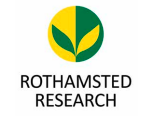
-
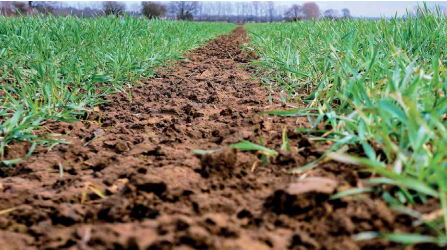
Spring Into Action: Choose Adjuvants To Push Herbicide And Fungicide Performance This Year.
How can you keep weeds and disease at bay this spring? As warmer weather arrives and the season gets underway, we explore here the role of adjuvants in boosting the performance of herbicides and fungicides on farm to optimise weed and disease control.
Right time, right place
Bumper harvests are made in spring. Where every kilo counts, optimising a fit and healthy crop free from weed and disease competition is absolutely essential. Of course, this is easier said than done. As certain species become resistant to herbicides and fungicides, restrictions tighten and active ingredients disappear from the crop protection toolbox, the job certainly isn’t getting any easier for farmers. If conditions are challenging during application, as they so often are these days, things become even more stressful. Plants struggle, workloads rise and yields fall.

There isn’t much we can do about the weather. What we can do is make sure that crop protection products are delivered to the right place, at the right time – and that the tools we have are working as hard as possible. This is where adjuvants are worth their weight in gold. E m p l o y i n g a suitable a d j u v a n t e n s u r e s herbicides and fungicides are delivered exactly where needed, m a x i m i s i n g effectiveness and protecting yield. For those looking to get the most out of rotational weed control this spring, they are practically a secret weapon.
Kick-start your weed control programmes
We know that spring crops are limited in their post-emergence armoury. To give your plants the best start in life, it’s a matter of control. While the majority of black-grass germinates in autumn, the startling truth is it only takes 12 plants/ m² to reduce yield by as much as 5% and power seed return of an eye-watering 144m seeds per hectare. Pre-emergence residual herbicides need to be applied with precision in problem fields to protect yield, keep on top of populations and prevent issues in the next crop. Working in lighter soils, getting rid of spring germinators early – like knotgrass, black bindweed and redshank – defends sugar beet, potatoes and the like – crops where early establishment, free from weed competition is vital to protect yield. During the pre/peri-emergence spray timing your aim is to get maximum coverage with the spray and retain the herbicide in the top 5cm of the soil to control new flushes of germinating weeds that may appear over time.

This can be challenging for three reasons:
1. Coverage can be compromised by drift, reducing the applied dose, missing parts of the soil altogether and allowing weeds to germinate and outstay their welcome.
2. The dry soils typically seen in spring have an impact on performance.
3. Levels of moisture in the soil can affect retention and therefore leach the potential of the herbicide.
Designed to reduce drift, a low-drift nozzle produces bigger droplets but reduces coverage –meaning we still have problems two and three to deal with. This is where a residual herbicide adjuvant like our Backrow product can help. Adding Backrow to spray water both reduces drift and improves coverage. The product helps soil retain herbicide and moisture in the top 5cm of soil for up to eight weeks and prevents herbicides leaching to groundwater or the roots of the crop itself. Used in this way, Backrow improves the efficacy and longevity of weed control and general crop safety, particularly in light soils. Field-scale research on onions has shown that where Backrow was applied pre-emergence, the leaching of all subsequent crop protection products was dramatically reduced. Follow-up work using lysimeters in a controlled environment revealed that the product upped water retention by 33% and diminished leaching by an incredible 62%.
Four ways Backrow can help increase overall weed control
Adding Backrow to your weed control has four central benefits:
• Increases contact between the herbicide and the weed
• Increases effectiveness of herbicide in dry conditions
•Increases longevity of weed control
• Improves crop safety
Over the past nine years, replicated trials have been carried out with a range of herbicides applied both pre and periemergence. The results of these trials have shown conclusively that Backrow advances the performance of herbicides by an average of 9%. Let’s crunch the numbers; for a black-grass population of 500 heads per m², 9% means a yield benefit of 0.45 t/ha, or to put it in financial terms, a margin of roughly £80/ ha. Importantly, it also means a reduction in black-grass seed return to the tune of 270,000 seeds per hectare (based on seed viability of 60%), protecting future crops from competition.
Broadleaf weed control in cereals: +13%
Broadleaf weed control in combining peas: +13%
Broadleaf weed control in spring beans: +10%
Broadleaf and grass-weed control in potatoes: +8%
Enhancing weed control post-emergence
Once weeds have surfaced, we are dealing with an entirely new target; aiming to get herbicide into a small established weed, rather than sufficient coverage of the bare soil. If the weed gets particularly big, hairy, or waxy in texture, things become even more tricky. What then if applications are delayed due to weather or workload? … If you find yourself with an out-ofcontrol weed situation, choose your solution wisely. A good adjuvant should reduce drift and improve retention on the leaf, rather than allowing the herbicide to simply bounce or run off the surface.
It will aid spreading across the leaf to optimise entry points, improve penetration and increase uptake. Sulfonylurea (SU) herbicides in particular benefit greatly from the addition of an adjuvant; on a molecular level, the very small nature of the active ingredient makes it hard to wet in formulations. Adjuvants like Arma and Kantor are ideal in this situation. Kantor would be the better choice to reduce drift and/or when using hefty tank mixtures. It has the ability to keep complex mixtures stable within the solution; a notable benefit with Basagran in spring beans which can be “hot” on the crop.
Pushing the performance of fungicides
While SDHI/azole mixtures have proven effective in controlling Septoria in cereals, monitoring data shows there has been another slide in sensitivity to SDHIs and azole chemistry. At present, we’re also experiencing disease control challenges in controlling Cercospera in sugar beet and Ramularia in barley, to name a few vicious examples. We’re not saying that adjuvants are the holy grail, but there’s no denying resistance poses a significant threat to the ongoing performance of fungicides. By optimising the application process, we can not only increase efficacy and yield, but importantly also reduce negative genetic effects and slow resistance.
During fungicide application the aim is to get as much of the active ingredient inside leaves as is possible. The surface area to hit is large and we need to protect it all. While multi-sites act as a protectant, they don’t move on the leaf. This means they can only protect the portion of the leaf they actually cover. If the base of the leaf doesn’t receive adequate coverage, the fungicide will be prevented from moving downwards, leaving that part of the leaf either completely unprotected or having received a sub-lethal dose of the active ingredient.
Although they work slightly differently, both the Arma and Kantor products will improve spreading and uptake to protect the whole crop. Prothioconazole-based mixtures will benefit in particular as it is a large molecule which needs to be converted to desthiocolnazole inside the leaf for it to be “activated” – so the quicker it gets inside, the faster it starts working. Extensive trials over the past seven years have also shown that where Kantor is added to prothioconazolebased sprays with chlorothalonil, antagnosism is reduced and yield is improved.
Over 6 years of trials, 44 comparisons, average yield benefit in winter wheat across all timings: +0.28 t/ha
+14% improvement in Cercospera control in sugar beet with epoxiconazole + thiphanate-methyl
Up to 18% improvement in Downey mildew control in onions with Invader
Our top tips
So how to get the best out of your herbicides and fungicides this spring?
• Choose your crop protection carefully and make sure it is applied in the right place, at the right time.
• Incorporate a suitable adjuvant to ensure your herbicides and fungicides are working as hard as possible.
• Aim for the highest levels of control when applying pre-emergence residual herbicides to give crops the best possible start in life.
• A good offence is the best defence. Use pre-emergence herbicides in problem fields in the spring to keep on top of weeds and safeguard against issues in the next crop.
• Rid lighter soils of spring germinators like knotgrass, black bindweed and redshank as early as possible. In crops like sugar beet and potatoes, doing so is crucial to protect yield.
• Employ crop rotation where necessary to crowd out weeds via competition.
• Pre/peri-emergence, choose a low-drift nozzle and aim for max coverage. Adding a residual herbicide adjuvant like Backrow can help optimise soil coverage and retain herbicide and moisture in the top 5cm of soil for up to 8 weeks.
• Post-emergence, aim to get as much of the active ingredient in the weed leaf as possible. Adjuvants Arma and Kantor improve coverage and uptake to control as many weeds as possible.
• To boost the performance of fungicides, apply an adjuvant like Arma or Kantor to boost spray coverage and uptake to protect the whole crop.
Adjuvants like Backrow, Arma and Kantor are a valuable tool, pushing performance of herbicides and fungicides and helping you get the most from your crop in health and yield. To discuss individual scenarios or to request product guides, please feel free to get in contact with us at info@interagro.co.uk.

-
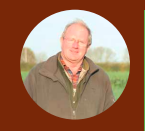
Farmer Focus – David White
Writing on 28th Feb 2019, David White brings readers up to date on early spring work on this Cambridgeshire farm.

Farming 160ha of combinable crops on light “boys” land over chalk between Cambridge and Newmarket. I’m 100% combinable having been a sugar beet grower since the days of hand hoeing as well as offering a drilling and harvesting service with a 6 row tanker in the past, I have since stopped growing beet when I wanted to start direct drilling. All crops types are grown for premium markets and are stored in Camgrain central storage which makes having a rotation of 6 or 7 crops and different varieties very easy.
Spring drilling Spring Beans and Elyann Oats were in the ground by Feb 27th with only a little barley to go into a thick cover crop of Black Oats and Vetch on some land with blackgrass issues, so no hurry for that. There has been some deliberation as to whether its been too early to sow but conditions have been too perfect to ignore. What a difference from last year which wasn’t great for spring crops.
The oats were drilled into 18” high desiccated Linseed/Phacelia mix and I had some concerns about the linseed being picked up on my milled toothed 750a covering wheels and wrapping on the axles. This fear proved to be unfounded as certainly drilling into the cover when it was dry was 100% trouble free. Small oat seed of 36TGW required 136kg/ha to establish 350 plants. Half the N around 65kgs will go on following the drill to kick it off and N cores will help decide on the balance required. Three metre wide assist strips for pollen and nectar species have been left through a large field which will be sown later in March.
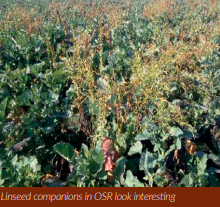
Rape companions Spring beans (inc some Berseem) have proved most successful again in reducing CSFB larvae numbers. Although the plants are carrying more burden than last year most fields are at early stem extension with visible flower buds and will require some PGR treatment I’m advised, some will be done. This is in stark contrast to many conventionally established fields in the area that are shrinking and slowing turning brown! Interestingly a later Sept 2nd sown high seed rate no companion area is suffering much more from larvae even though it emerged after the peak CSFB flight period.
Nitrogen All the OSR and winter wheat have now had some nitrogen although they didn’t look like there was any urgency. We’ve had a dry winter so little N will have been leached but the rape has got to a good growth stage with only 29 kgs/N applied and the wheat looked very well pre first application which suggests to me that the companions and enhanced soil biology achieved through not tilling is doing something for me. 900 mm deep N cores kindly taken by Niab show 22-29 kgs/N available over that profile.
These soil cores also showed the subsoil to be very dry! Cane molasses was added to the liquid N+S application at 5lts/ha without any problems. I cautiously pre mixed 50-50 with water in IBCs as I wasn’t sure how the molasses handled. This makes measuring into the sprayer easy through a suction probe using the scale on the container. A series of nitrogen variation tramline trials is being set up to compare to a soil biology only control.

Growing my own companion seed Winter peas are now about 75mm high and at sowing rate of 100 seeds/ sq mt look fine. After some head scratching for a way to keep my vetch off the ground enough to enable a chance of successful combining I’ve sown it into a companion of spring beans at 80 kgs/ha, watch his space. I have started taking tissue samples to check on plant nutrition status again with the first results in showing most main elements being find. As a BASE UK committee member I’m involved with the planning of events for the late spring/early summer including an interesting European trip which members can look forward to.
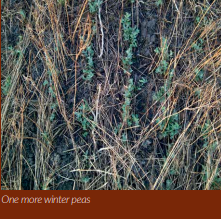
-

Practical Advice For Improving Soil Health
Soil health is one of the government’s main concerns relating to the future of agriculture, and with many farmers
now turning towards conservation and biological farming, it is important to get soil heath, the cornerstone of these
principles, right.George Hepburn, biological soils expert at QLF Agronomy, gives his six practical steps for improving soil health, no
matter what farming system.Analysis
When looking to increase soil health, the first thing I look at is the soil itself. Go out with a spade, or in extreme cases a digger, and physically look at the soil. The presence of deep rooting systems, good soil aggregation and abundance of visible soil life are all key indicators of a healthy soil structure. To test this, look at how far rooting is going down and whether or not there are any fine hair roots. It’s also useful to smell the soil – healthy soil smells almost like dark chocolate, whereas anaerobic soils have an unpleasant smell.
Assess the aggregation of the soil to see if it’s crumbly or compacted, and check for soil life, such as millipedes, beetles and worms. You should see around 10 to 20 worms per spade in a healthy soil. It’s also useful to compare soil in the field with that from under the hedgerow, where soil health and structure won’t have been affected by cultivations or compaction.

Once you’ve assessed the look and feel of the soil, taking a soil test is the next step, because if you don’t measure it, you can’t manage it. However, it’s important to note that a standard UK test only provides N, P, K, Mg and pH measurements, which isn’t enough to accurately determine the level of soil health. I recommend a full spectrum test, which costs around £30 per sample. This will provide a more accurate picture of the soil make-up, by measuring calcium, boron and organic matter (OM) levels, pH, and the cation-exchange capacity (CEC) of your soil. It doesn’t really matter which lab you use, but once you have chosen one stick with it for consistency, as methods of analysis do vary. Once you’ve assessed the condition of your soil, you can then start to make changes.
Soil structure
Before you can affect the biology of the soil, the structure needs to be right. The soil micro flora and fauna need air to breathe, and food and water in the right proportions. The ideal soil structural makeup to provide this is 45% minerals, 5% OM, 25% air and 25% water. Calcium and magnesium are extremely important minerals as they help to define soil structure. Calcium deflocculates the soil, allowing air in and water out, and magnesium does the opposite, making the soil tight and sticky. Therefore, it’s essential to get this balance right. If there’s an imbalance you may need to apply gypsum (calcium sulphate) to help lower magnesium levels or apply calcium lime or magnesium lime. It may be the case that simple cultivation techniques such as subsoiling, ploughing or getting a tine in to aerate the soil, could be what you need to improve the structure.
Soil fertility plan
After creating the right conditions for the soil biology to thrive, you can now concentrate on providing the right inputs to make the soil more fertile. Traditional fertilisers, although necessary, generally do not improve the fertility of the soil itself. For example, as much as 40% of nitrogen can be lost to leaching, immobilisation by soil microbes, denitrification and volatilisation. This can leave you out of pocket due to wasted resources and can potentially reduce yields. Through experience, I would apply a new organically based input each year on each field to feed the soil. This could be FYM, compost, chopped straw, cover crops, lime, seaweed, gypsum, liquid carbon-based fertilisers or biologicals. These will all encourage the soil biology either by improving its habitat or directly feeding it.
Use quality inputs
When implementing a soil fertility plan, make sure you’re using the best fertiliser for your soil. This could simply mean switching from muriate of potash (MOP) to sulphate of potash (SOP), however there are also many other considerations when choosing inputs. We tend to focus on N, P and K but, although they are important, they’re a small part of the picture. Micro nutrients such as boron, zinc and manganese, are also important to soil fertility and include inputs that contain a range of nutrients can be much better for the soil, for example, Limex, P grow.
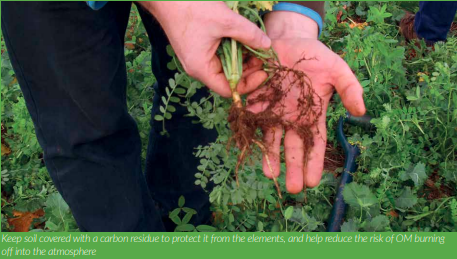
Ensure you’re using the right type of Nitrogen for your crop, establish if there is enough sulphur or phosphate, if the phosphate reserves are available to the plant and most importantly if you’re getting the most out of your applied fertiliser. There are a wide range of phosphate sources available, for example TSP is the most popular but the poorest efficiency of around 20%. Ironically some of the most efficient sources such as sewage sludge, fibrophos, FYM and digestate, are some of the cheapest. The added value of including organic sources of P, is that they also contain a mixture of other nutrients, such as sulphur and trace elements. Using a liquid carbon-based fertiliser, such as L-CBF BOOST™, can improve uptake efficiencies by stimulating the soil biology and providing an energy source which aids the breakdown of nutrients into a more readily available format for the plant.
Carbon
Although nitrogen is essential for plant growth, don’t overlook carbon, and especially the carbon to nitrogen ratio. This is vital because when the carbon to nitrogen ratio isn’t balanced and high nitrogen inputs or amendments are used, microbes then feed on the soil organic matter for their carbon, respiring carbon dioxide back into the atmosphere, depleting carbon and causing long term soil fertility and environmental problems. Including a carbon source with any applied nutrient will help to stabilise and buffer the nutrient.
This is because the carbon binds to the nutrients, chelating and complexing them, which improves plant uptake. Applying a carbon source such as carbon-based liquid fertiliser, L-CBF BOOST™, seaweed extracts, organic acids, compost teas, compost or manure, can improve nutrient cycling and reduce losses, meaning you’re getting the most out of the input. Wherever you can, keep the soil covered with a carbon residue to protect the soil from the elements, and help reduce the risk of OM burning off into the atmosphere. This can be achieved with cover and companion crops.

Evaluate
Finally, evaluation is crucial. Testing the soil and the plant itself will help you to determine if your work has been successful. Tissue testing can give an indication of the uptake of nutrients by the plant and help to determine if any additional remedial work and fertiliser applications have been effective. This is even more important on land where you’ve cut back on nutrients. Take the first test when crops begin to grow in spring and repeat on a fieldby-field basis two to three times per growing season, as a deficiency in just one trace mineral could limit yields. If deficiencies are seen, consider foliar applications of micro and macro nutrients to address this. After six months, go out with a spade to check soil structure and compaction where you’ve made changes. Analyse the results of soil samples and tissue tests and continue to take them regularly. Yield is important, but what we should be aiming for is long-term soil fertility so that we can continue to use the land for generations to come. For more information on improving your soil health contact George at george@qlf.co.uk.
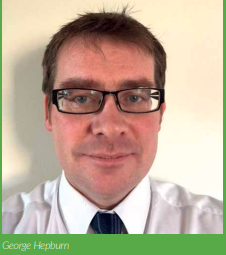
-
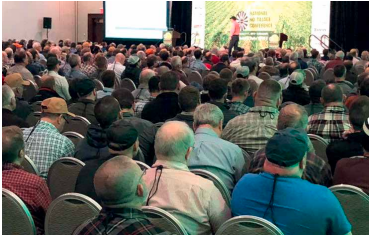
27TH Annual US National No-Tillage Conference
Written by Ian Gould, Director of Oakbank Game and Conservation Ltd
In an attempt to take myself out of my own comfort zone and into a new learning arena, I decided to venture across the “Pond” and immerse myself in US Agriculture for a week. Arriving in Indianapolis in January 2019 I was intent on absorbing as much as I could at the US National No-Till Conference, an event that attracted almost 1000 farmers, advisors and suppliers. There was a definite bias towards Maize and Soybean growing at the event, but there was a great deal to take away that we could benefit from in the UK.
The first thing I took away was the level of interest in regenerative methods from outside agriculture. Much of this was driven by projects to protect waterways, such as the Chesapeake Bay, but also from large businesses that clearly think that there is commercial advantage to be gained by showing their environmental credentials. These include Wrangler Jeans, who are encouraging their cotton growers to use cover crops and General Mills who have started to set up strategic supply agreements with specific growers. I met a number of USDA and NRCS (Natural Resources Conservation Service) staff at the conference and they were liaising with the scientific / academic community and farmers to promote best practice.
The farmers that spoke during the event shared many of their successes and failures in some honest and informative presentations. They all spoke about how they started out in a small way without spending too much money, but wanted to see how things worked on their own farms. They all continue to trial new ideas and push the development of their own production systems.
I enjoyed the talk by Trey Hill, who farms 13,000 acres in the Chesapeake Bay watershed. He was sceptical about cover crops initially but necessity drove him to “Plant Green” one year and he has never looked back. His key learning points were that consistency in the cover crop is crucial, so that after termination the conditions are even across the field. If not, establishment of the next crop could be highly variable. Trey also mentioned that he does struggle with slugs sometimes, but this has not diminished his efforts as he has experienced so many benefits from cover cropping the land. He said that he loves his soil so much now, he never wants to see it!
Rick Clark farms 7000 acres in Indiana and he stressed the importance of keeping good data and using this effectively to make better decisions. Don’t rely on your memory as this has a habit of filtering the data over time. Rick’s mantra was “good data leads to good decisions which lead you to a position of strength.” He believes that using cover crops to “Armour the soil” gives a good return on investment.
I had been looking forward to hearing David Brandt speak as he was someone that I had watched on YouTube before travelling to the USA. David farms 1100 acres in Ohio and has been No-Till Farming since 1971 and using cover crops since 1978, so there are few more experienced growers. His standard cover crop mix contains at least 10 species, including 4 different legumes. David has long term plans for his rotation, including where the cover crops will fit in. This then feeds into the planning for herbicides, etc so that they do not run into problems with residual chemicals. David is not an organic farmer, but he certainly learns from those principles, using very little in the way of fertiliser or pesticides. Brandt says he didn’t realize microbes were so important to farming a few years ago. “But I’ve read about how vital they are, and now I see as they increase, we see more good things happening in our soil— more nutrients being released, more water infiltrating into the soil. The more microbial activity we have, the better off we are,” he says.
“I’m really intrigued with the amount of water infiltration we’re seeing with our cover crops. As we go to cover crops with deeper roots, and bigger root masses, we’re seeing rainfall dissipate through the soil better. We don’t have water pockets in our tight clay soils any more.”
Cover crops also moderate soil temperatures. “On hot summer days, with air temperatures over a hundred degrees, our neighbours had soil temperatures of 118 degrees and ours was 86 degrees. Our corn really looked great at those times,” Brandt says.
Away from the main presentations there were so many learning moments, either in the smaller breakout sessions or over a drink at the bar. I was lucky to spend a few hours with Steve Groff who is known to many as the Cover Crop Coach. Steve has worked in this area for many years and has extensive knowledge of the subject. His research led to the development of the Tillage Radish but he is now focussed on developing best practice and educating farmers and advisors around the world. His advice to all cover crop users is “know what you are trying to accomplish!” Without a clear goal, how will you ever know if you are getting anywhere.
The other key piece of advice that Steve is always giving is that when it comes to planting “Every day counts!” Be organised in good time for planting season and get the drill into the field as soon as possible after harvest. We discussed intercropping and seeding into the previous cash crop, which with some of the new drills on the market could certainly become more achievable. Steve also emphasised that the most useful tool for a cover crop farmer is his spade, get out in the field and start to investigate what is going on as “showing beats telling!”

If you are particularly interested in drills and coulter technology I would recommend looking up Loran Steinlage (@ FLOLOfarms) who has a real in-depth knowledge of the subject. I don’t imagine any equipment in his barn is still exactly as it arrived as he builds a lot of it himself or redesigns old kit. His understanding of how metal and soil interact was fascinating and I look forward to seeing what his new role with Dawn Equipment will produce. By stepping away from our normal constraints of UK thinking I have confirmed some principles that I had and certainly challenged some others. The focus on profit per acre instead of simply yield was very strong, and the stacking of enterprises (Crops + Livestock) was diversifying the income streams and spreading risk for many.
I did enjoy the positivity and openness for sharing information, despite what has clearly been a tricky time for US farmers. The massive shift into GMO Maize and Soya has led to a number of problems but it has also created opportunities for individual businesses to diversify into nonGMO markets. They are finding consumer demand for their products increasing and the most successful businesses are very close to their end markets, keeping far more of what the consumer spends within the farm business.
It was a very interesting and enjoyable trip, one that has led to continuing conversations with new friends via Skype and Social Media.
Written by James Warne of Soil First Farming
The 28th annual National NoTillage Conference will be held in St Louis from 7th to 10th January 2020.
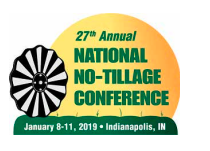
-

Brix, Magnesium, Manganese, And Plant Health?
Written by James Warne of Soil First Farming
Ever measured the brix levels of your crops? Been told that if you achieve the magic figure of ~15% brix then you won’t
have an issue with pest and disease?I have spent the last couple of years testing brix (during the spring) of most crops I visit and have never managed to get anywhere near to 15%. For a while I blamed my refractometer so got that tested against another one, no problem there. I then decided I must be measuring the sap from the wrong part of the plant. My understanding is that the sap should be taken from the newest ‘sink’, i.e. the newest emerging leaf. So I tried this as well with little success. However with another approaching growing season I intend to try again.
So what does brix measure? The general consensus is it measures the sucrose content of the plant sap, but this is only part of the story. It turns out that brix is actually a measure of all dissolved solids within the sap. So when measuring brix you are also measuring other solids contained within the plant sap although the largest proportion of these should be sucrose. These solids could be other sugars such as glucose and fructose although these are usually converted to sucrose for phloem transport; it could be amino acids, proteins and minerals also be found within the sap. Brix levels should be measured between 12pm and 4pm on bright days to get a meaningful result. The bris should then drop overnight as the sucrose has been delivered to the sink. If the brix does not fall by a considerable amount this may indicate a shortage of boron.
Why should you be worried at all about brix, after all its principally just a measure of the plant sugar? Well if your desire is to lower inputs and to get off the high input farming treadmill then creating an healthy plant community is essential to achieving a lower-input crop without reducing the output. Essentially it’s a simple measure of our abilities as crop managers at light capture and chlorophyll production.
So what can affect brix levels? Brix can be negatively affected by most pesticide applications and some fertilizer applications such as ammonium nitrate as both place undue stress upon the crop. So how do we positively affect the concentration of sucose within the sap? As previously mentioned sucrose is the plants transport sugar and is made from the condensation of glucose and fructose, the primary products of photosynthesis. Plants produces glucose as the product of photosynthesis. Plants can also manufacture fructose, which is chemically very similar to glucose. It then combines these two monosaccharides into the disaccharide sucrose for transport from the source around the plant to the sink. The process of combining glucose and fructose into sucrose is known as condensation and is controlled by the enzyme sucrase-p-synthase. Potassium is well known to enable the sucrose to enter the phloem transport system. Once the sucrose has reached its sink the plant hydrolyses the sucrose into glucose and fructose to provide energy via the enzyme sucrase.
Photosynthesis is carried out in the chloroplasts by chlorophyll molecules. Magnesium and nitrogen are central to the chlorophyll molecule. We can assume that the crop is able to access sufficient nitrogen as most crops receive more than they can utilize and very rarely show any signs of deficiency, more likely than not most crops actually reveal an excess of nitrate. It is also worth noting that excess nitrate within the plant can actually depress brix as the crop uses more energy to assimilate nitrate than it does using ammonium. Can we ensure the crop receives all the magnesium it requires, especially in high pH soils or soils with excess potassium or low magnesium?
Of equal importance is manganese. Manganese is central to over 35 enzyme functions; it’s critical to chloroplast production, photosynthesis and the photosystem II process; nitrogen metabolism and nitrogen assimilation. Manganese is also believed to be essential to sucrose synthase. Manganese is also shown to be central to the plant ability to synthesis hydrogen peroxide which helps the plant defend against pathogens. Manganese is important for the process of lignification which give the plants strength to stand and resist pathogens within the roots.

Manganese deficiency is a common sight in cereals in the UK. The plant may be suffering from a shortage of manganese before we see physical symptoms. By the time we see the classic yellowing of the crop we are already two weeks too late, consequently yield will have been compromised. It takes around two weeks for the shortage of manganese to reveal itself with leaf symptoms so from that point on we are fire-fighting the deficiency. Over 95% of all the soil analysis we undertake shows very low levels of available soil manganese. While the obvious solution is to re-mineralise the soil using manganese sulphate or similar, in reality this proves expensive and doesn’t help with some of the underlying causes of deficiency such as soil pH.
Manganese deficiency is typical associated with high pH soils, loose well aerated (cultivated soils) and lighter textured soils. Soils high in iron can also reduce manganese availability. Manganese has low phloem mobility in the plant therefore regular foliar applications are necessary in situations where deficiency has been previously seen or maybe expected. Where the deficiency has already expressed itself in the form of visible symptoms a minimum of 750g of manganese as foliar manganese sulphate is required per application if you are using a straight un-chelated product. This can be reduced to 150g per application if using a quality chelated product. As with all foliar applications you always need to ask yourself the vital question; how does the positively charged metal pass through the negatively charged leaf surface? If your product or supplier cannot answer this question it probably means the product hasn’t addressed this fundamental question.
References.
Mineral nutrition of higher plants. Marschner. 2012
Principles of plant nutrition. Mengel & Kirkby. 2001
Applied soil trace elements. Davies. 1980.
-

Drill Manufacturers In Focus…
WHEN ADOPTING DIRECT DRILLING, VERSATILITY IS KEY

by Simon Clarke, Technical and Sales Manager for Simtech Aitchison
It is probably true to say that no other make of direct drill is working over such a wide range of agricultural environments as the Simtech T-Sem drill. Vineyards, walnut groves, upland and lowland pastures, the often arid and rocky conditions of places such as Corsica and the arable areas of most Western European countries, are just a few examples of the diverse range of uses encountered by T-Sem drills. They also have a heritage stretching back further than most. But with all this diversity, it is quite surprising to realise that, with the exception of some design tweaks, the same basic principal of operation has remained unchanged.
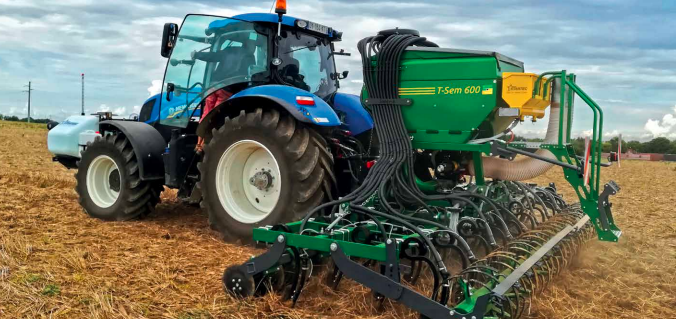
The unique T-Slot coulter creates a perfect environment for seed to germinate and develop. At only 10mm wide at its leading edge it is designed to cause as little surface disturbance as possible. Preceded by a vertical cutting disc, that creates a path through surface trash, the inverted T-slot coulter ensures that the seed is always placed on a firm, but importantly un-compacted base, with the vibrating tine creating the tilth to cover it. In soil held together with a large amount of root material the T-slot coulter creates a void in the soil, which is like a mini greenhouse, maintaining humidity to enhance the speed of germination, but at the same time allowing sunlight to penetrate through the partially open slot. This scientifically-proven feature allows small seeds to be placed deeper than would normally be viable into an environment which is much less likely to result in poor germination or seedlings drying out. Observers of the T-Sem say, “there is nothing to close the slot”, but in many conditions this is strength not a weakness, because to do so would be to place the seed too deeply to germinate.
Now with the current wide adoption of cover crops the T-Sem really comes into its own. Summer drilling, directly behind the combine is to say the least, challenging. Often quite hard ground conditions and large amounts of surface trash means that disc drills will struggle. If they can penetrate the soil, there is still the problem of “hair-pinning” the trash, which limits seed to soil contact and also rapidly dries out the slot. The power of the 30mm square double coil tine, means that you can place the seed deep enough to find moisture and give them the time needed to put their first roots down.
The other less obvious reason for investing in a T-Sem is that you are buying into the vast amount of experience that Simtech staff have accumulated through working with farmers across Europe for the past 2 decades. In the particular case of cover crops, the much earlier adoption of this practise in France has given us a head start in guiding our customers in the UK through this quite difficult, but in our view essential part of Conservation Agriculture.
So this is the strength of the Simtech brand. A product that works across such a wide range of conditions, which can cope with the extremes of climate and soil such as ours, must surely be a worthy of consideration.
-
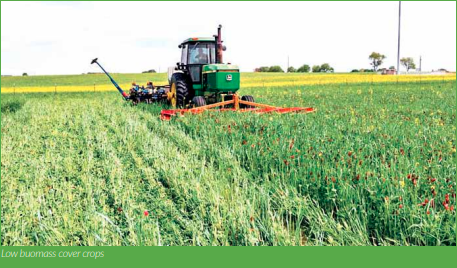
Tips For Managing Cover Crop Mixes For More No-Till Benefits
Written byAngela Lovell, originally published in No-Till Farmer USA in November 2018
Choosing a cover crop cocktail is only a start, says Adam Daugherty, as managing carbon-to-nitrogen ratios and adapting planting strategies play a big role in success. There are many variables for growers to consider when they’re implementing cover-crop mixes into their no-till rotation — including mix design, carbonto-nitrogen (C:N) ratios, cash crop goals, termination strategies and biomass management. “The goals will be different for everyone and will change from field to field, with changing conditions and with time,” says NRCS district conservationist Adam Daugherty.

Here are strategies for thinking through some of these important decisions that were shared by Daugherty at the National No-Tillage Conference last January. Staying in Balance It’s vitally important for no-tillers to understand the C:N ratio of crop residue and how they play a role in the soil. C:N ratios are especially important when ascertaining how long it will take for soil microbes to break down residue. “The soil is a jungle ecosystem,” says Daugherty. “It has big and little critters. They all have to eat and they all play a role in cycling residue.” The ideal C:N ratio to feed microbiology in the soil, so it can efficiently consume biomass and cycle nutrients, is 24:1. Higher C:N ratios will slow down the decomposition of biomass and lower C:N ratios will speed it up, Daugherty says.
Most annual cropping systems have a high C:N ratio: wheat straw is 80:1 and corn stover is 57:1, which means residue decomposes slowly and leaves more protective biomass on the soil surface. Plants with a lower C:N ratio (legume hay is 17:1) decompose residue faster and result in less cover being left on the soil surface. Daugherty generally advises no-tillers to stay on the high end of the C:N ratio because one of the first things that destroys soil function is leaving it naked. “I want to keep the soil covered the best I can so I shift a little to the high side on the C:N ratio, especially in fields that have had cover crops for a couple of years and I’m getting a good idea of what they’ve got going on,” he says.
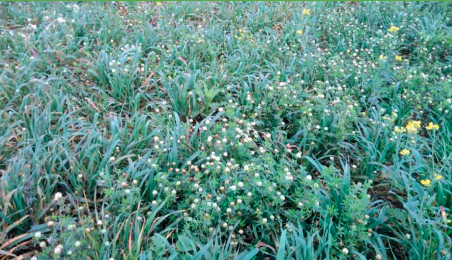
Keep it Simple
Don’t over-complicate cover-crop mixes, advises Daugherty, but aim for one that has at least some diversity with grasses, legumes and brassicas. What generally works for Daugherty’s growers is 20 pounds an acre of legumes, 40 pounds an acre of grasses and 2 pounds of brassicas. To achieve this ratio, a fairly common mix would be 10 pounds per acre each Austrian winter peas and oats, 5 pounds of crimson clover, 5 pounds of hairy vetch, 15 pounds each of cereal rye and triticale, 1½ pounds of Daikon radish and ½-pound of another broadleaf. “That’s a common mix for us and we can manage that mix to achieve a lower or higher ratio,” says Daugherty. “That’s another thing that diversity will let you do — get more flexibility in managing your C:N ratios.” He recommends growers try out online cover-crop calculators to see how different species, maturities and percentages can alter the C:N ratio.
Management Comes First
Daugherty says it’s better to manage a less-ambitious mix properly than choose a “silver-bullet mix” and manage it poorly. “I design in the fall and manage in the spring for my desired results. This is going to hold true no matter where you’re at,” he says. “You can do the same thing with summer mixes. It all boils down to what my goals are for the field and the logistics that I’m going to manage to reach those goals in the spring.”
Happy Medium
The ideal carbon-to-nitrogen (C:N) ratio to feed soil microbiology — so it can efficiently consume biomass and cycle nutrients — is 24:1, says Adam Daugherty. Higher C:N ratios will slow down the decomposition of biomass and lower C:N ratios will speed it up, so it’s best for no-tillers to look for balance in their cover-crop mixes.
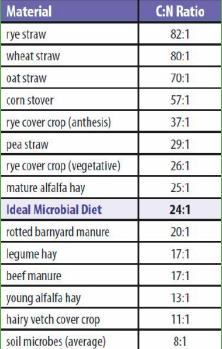
No-tillers should always be ready for something unexpected to happen and have a Plan B to deal with it. Daugherty showed growers a slide of two fields planted side by side with the same cover crop mix, on the same day and managed the same way, and while one field was an explosion of diversity the other was almost entirely heavy vetch. “I don’t know what went on, but I think that the soil gets the ability to dominate what species it needs growing,” he says. “We now have to manage this field differently and set up to plant differently. Even though we planned everything in the fall, sometimes crazy stuff happens, but it’s not the end of the world. We can manage anything.”
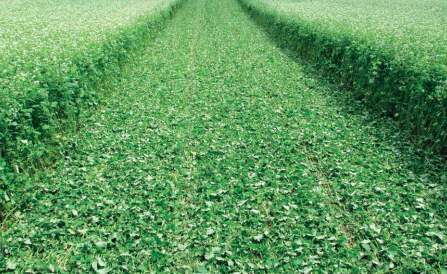
Art, Not Science
Growing cover crops is an art, not an exact science, says Daugherty. “You cannot write one recipe and just stick to it,” he says. “You’ve got to be very dynamic in your thought process. You have got to be able to switch on the go and do something different on Wednesday than you did Monday. It’s that variable.” Specifically, it’s important to do regular soil evaluations and analyse not just the nitrogen (N), phosphorus and potassium values but things such as microbial biomass, diversity index, organic matter, fungi and CO₂ content. That will help to determine the cover-crop mix and management that fits best.
“We can use this data up front to start making predictions, so we don’t plant something with too low a C:N ratio that we know is going to disintegrate,” Daugherty says.
Look and Listen
The final grade card is learning to read your field, Daugherty says. He cautions that there’s no soil test available that is more effective than growers who develop an ability to read the symptoms of what’s happening in their fields. Once a grower gets soil biology activated and working properly, they must keep feeding it to ensure there’s enough of what the system requires — especially carbon — to meet both soil and crop needs. “Carbon is our limiting nutrient, but liquid carbon is a different feed from other forms, like organic matter,” says Daugherty.
“Primarily we’ll be growing a monoculture cash crop and for at least half the year we’re going to be very nondiverse in a system that wants to be diverse. “In general, as soil biology functions increase, more carbon needs to be managed in the mix.” Growers must monitor stand establishment of their cash crops, assess the amount of residue left on the ground throughout the crop’s growth cycle and, in the end, determine if they have achieved their goals for the crop and the soil. “I don’t really worry about this when I’m starting with a degraded system,” Daugherty says. “I want to start priming it with a lower C:N ratio. But three or four years on, as the system begins to work, you’ve got to start watching this.”
Seed Depth Rules
What never changes with a cover crop is the planting depth for the following cash crop. “If you don’t want a yield drag, whether it’s clean dirt, no-till dirt or biomass dirt, you have to plant at the right depth,” Daugherty says. “Covers are forgiving of a lot of things but that doesn’t mean you can go out there and broadcast corn.” “In general, as the soil biology functions increase, more carbon needs to be managed in the mix…”— Adam Daugherty What typically works for planting in Daugherty’s area of south-eastern Tennessee is working in good-to-dry conditions using a smooth, solid closing wheel which can be changed to a spiked closing wheel in wetter conditions.
Wrapping isn’t usually a problem when planting into green crops that are crimped or rolled as long as growers plant in the same direction as the crops are laying, he says. Growers in Coffee County generally have a fair amount of moisture during the spring and fall, which in their heavy clay loam soils means they have to be careful to avoid compaction of the seed trench. Cover crops are a definite plus in these conditions, especially when growers plant into green crops pre-harvest, but Daugherty notes the firmness of the ground underneath the cover crops or post-harvest residue is still an important consideration. He advises no-tillers evaluate the seed trench by reading the sidewalls. “When you start seeing air pockets there, let it dry up a day,” he says. “Just because you’re planting into covers doesn’t mean you can muddle corn in.”
Low and High
Planting cash crops into low or medium biomass situations requires different techniques, Daugherty explains. With low-biomass cover crops — which he defines as 6,000 pounds of biomass per acre or less — the cash crop is easier to plant, even when it’s into a cover crop. There’s generally no need to roll or crimp it to the ground first. “With low-biomass planting, I highly recommend no-tillers leave it green because your planting window is going to be a lot wider,” he says. “Once you spray it, you’re at the mercy of the sunshine and the rainfall.
There is nothing else out there to manage with. There won’t be any wrapping when you’re planting into this stuff.” What growers need to watch in a lowbiomass cover crop is that the following cash crop — especially a heavy feeder like corn — can begin to run out of carbon as the residue begins to disappear by June or July. “You can still grow good corn. Infiltration and a lot of things are better, but it’s not bio mimicry,” he says. “You’re not rejuvenating the resources to the degree that you can, so you won’t have the results you could potentially get.” In a medium situation with 6,000- 10,000 pounds of biomass per acre, Daugherty says growers can make tremendous strides and achieve extreme resource
-

Drill Manufacturers In Focus…
CORRECT ESTABLISHMENT IS VITAL TO GET THE BEST FROM SPRING-SOWN CROPS
Spring crops have become an increasingly important component in many arable rotations, but to deliver best performance they must be established correctly, writes Jeff Claydon, who farms in Suffolk and designed the Claydon OptiTill® System
In the last issue of Direct Driller magazine, I highlighted the importance of effective stubble management in producing excellent crops and outlined how to achieve it. This time I want to look at how we deal with spring crops, of which we have 65ha this year, comprising 16ha of beans and 49ha of oats. According to the meteorological calendar, spring starts on 1 March while the astrological spring begins on 20 March but whichever measure you go by farming at a high level involves so much more than simply working to a date in the diary. Having an innate feel for everything that is happening around you and working in harmony with Mother Nature are much more important. The need for this has been illustrated quite graphically in recent years.

The winter of 2017-2018 was long, cold, wet and seemed to go on forever. The weather was anything but spring-like right through until the end of April, then we had four months of severe drought. Conditions this year, at least up to the time of writing on 21 February, have been the exact opposite, with winter almost non-existent and soil temperatures already at 7°C. The contrast could not be more marked. Drilling spring crops started very early on the Claydon farm, with spring beans sown directly into over-wintered tilth with no need for a prior application of glyphosate on 29 January following over-night frost when the temperature dropped to -5°C. Soil conditions were excellent, better in fact than when we drilled winter beans in October, which just goes to show that you must take an opportunity when it presents itself. One of the hallmarks of a good farmer is that they constantly watch for the many signals which nature provides and work accordingly. This is particularly important when the countryside wakes up in the spring.
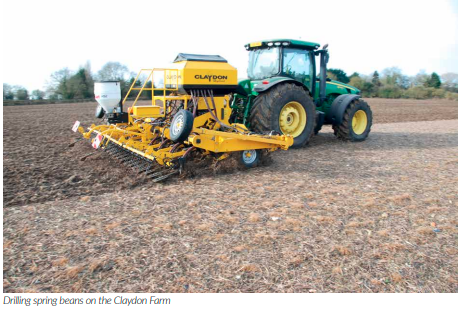
Wide window of opportunity
The big advantage of the Claydon Opti-Till® System which we operate is that our soils become better every year and are in excellent condition, their very high resilience and carrying capacity providing a wide window of opportunity in which to carry out field work. Crops are established in just onefifth of the time of a traditional ploughbased system and in one-third of the time needed for min-till, which means that it is much more flexible and allows us to wait until conditions are exactly right for the soils and crops rather than having to muddle them in.
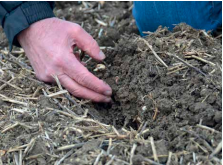
This way of working also greatly reduces the weather risk compared with a conventional system. The latter involves a sequence of cultivation operations that creates an unstructured soil profile with limited weight-bearing capability and an increased likelihood of sedimentation; this causes the soil to slump and become anaerobic. For example, had we ploughed the land destined for spring beans during the autumn and left it over winter, it would have laid wet at the end of January and no way could we have drilled the crop when we did. That would have had a substantial, adverse knock-on effect because we would have had to spend substantially more on ag-chems.
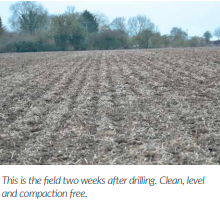
In the autumn we carried out a comprehensive stubble management programme which included several passes with the 15m straw harrow to encourage multiple flushes of volunteers and weeds, then killed off any remaining green material with a single application of glyphosate in November. This left the fields clean but with a shallow layer of surface tilth which provided ideal conditions over the winter and going into spring.
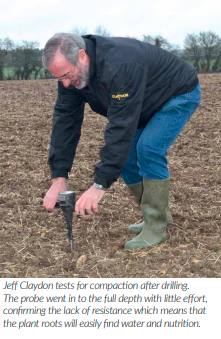
We were able to drill directly into this perfect growing environment because of the preparation work which had started back in the autumn using a combination of mechanical and chemical methods. With fewer herbicides now available, and remaining actives becoming more expensive and less reliable, it is vital to supplement them with mechanical methods, such as the straw harrow, to enhance the overall effectiveness of weed control. The other important advantage of this approach is that it creates 25mm to 30mm of tilth which retains moisture, allows the soil to breathe, makes it easier for worms to process the chopped straw and eventually covers the seed.
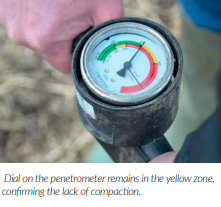
Pre-drilling routine
Before drilling, I always look at the weather forecast to check for three or four days of dry weather afterwards, because the last thing we want is heavy rain falling on freshly-drilled land. This would cause the surface of our heavy clay to cap, preventing air/water from penetrating and hindering the young seedlings’ emergence, at best stunting their development and perhaps even preventing them from doing so. Even if you get everything right in terms of preparing fields in the autumn there is no guarantee that when you leave them over winter they will still be ‘right’ in the spring so, before any crop goes in the ground, I carry out several checks to ensure that we are good to go with the drill.
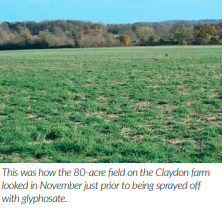
I look to see how many earthworm casts are present on the surface, because this is one of the easiest, quickest and best indicators of good soil health. There’s nothing better than seeing clusters of worm casts and finding plenty of worms in the soil profile, because the entire process of farming depends on them. The passages they create in the soil promote air exchange and drainage, so without these essential little creatures you will never come even close to maximising the potential of your soils or crops. Before drilling any field, I always dig into the soil to check its condition. Healthy soil should be dry, but not too dry, friable so that it crumbles easily between your fingers and have a lovely ‘fresh’ smell which indicates that plenty of air is present.
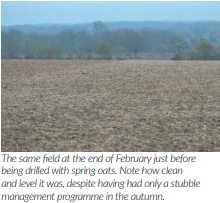
In contrast, anaerobic soil will be lifeless, sticky, clump together and smell stale because it cannot breathe and therefore contains very little oxygen. If that is the case, you need to re-consider how you are farming. Part of this might be to change your system. When assessing soil condition prior to drilling I also carry out several penetrometer tests across the field to check that there are no soil pans. If there are you feel them immediately because the probe becomes much more difficult to push into the ground and the needle on the dial swings into the red zone. Pans are not caused solely by compaction from heavy machinery or working when conditions are unfavourable but can result from the sedimentation of soils that have been over-cultivated and ‘settled out’ over the winter.
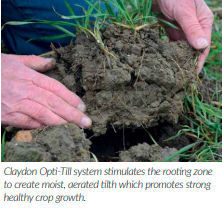
Because we drilled spring beans so early this year, we deliberately sowed them quite deep, 70mm to 80mm, so that they would take time to emerge, allowing early-germinating weeds to be taken out cheaply and effectively with one application of glyphosate before the crop came through. Evidence of good soil structure could clearly be seen when drilling the crop, because the tyres on our 330hp John Deere 8345R ran clean in the frosthardened soil and left barely a mark on the surface, even when turning on the headlands with the 6m Claydon Hybrid mounted drill raised. Even in the tyre tracks the penetrometer reading remained well within acceptable limits. Last year, when the beans were at the ‘rosette’ stage we went over the field with a harrow to take out any emerging weeds, even though most were barely visible. This operation left the beans untouched, prevented weeds from developing, maintained a shallow tilth to retain moisture and helped the crop get off to a good start. It would also prevent the soil from capping in the event of heavy rain and baking hard when it dried out.
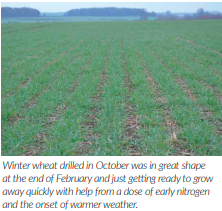
Since we started direct seeding 16 years ago, removing compaction is not something we have had to do because it has never been an issue. The soil has become so resilient that it has enormous carrying capacity and will easily support the weight of following operations. Our 5000-litre Knight selfpropelled sprayer weighs 18 tonnes, but it is used to apply nitrogen early in the season and that means crops get off to a flying start as soon as the weather turns warmer. The benefits of a resilient soil structure are evident throughout the farming year and, because it virtually eliminates machinery from sinking into the soil, the surface remains level, crops emerge unhindered, while field operations can be carried out faster, more accurately, more comfortably with less likelihood of damaging machinery. There is no downside and I will talk more about this in the next issue.
Fine-tuning production is essential
Whatever your views on Brexit, whether for or against, this prolonged process has demonstrated quite clearly that as farmers we must become even more efficient and self-sufficient. Farming is a very traditional industry and despite evidence to the contrary, many involved remain stuck in ‘The Cultivation Trap’, using traditional techniques and machinery which are time consuming, expensive, damage the soil, use large amounts of diesel and release large quantities of soil organic carbon. The key question we all must now ask is ‘how am I going to reduce my production costs to a base level which will enable me to compete in a global market, yet continue to operate a financially and agronomically viable farming business? With seed, ag-chems and fertilisers offering only limited scope for savings the focus must be on cutting establishment and machinery costs. There are many ways to do so, but critically it must be done without compromising yields and output, which means having a low-cost system which is reliable and repeatable.

Some farmers will continue as they have regardless, others will use some form of min-till to establish crops, but move a lot of soil and incur excessive costs in the process, while others will simply cut seed into the ground using a zero-till drill, but the UK’s maritime climate means that presents a huge risk and is like playing Russian Roulette with the future of your farm.
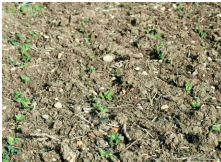
Done correctly, direct seeding using the Opti-Till® System provides a thoroughly tried and tested method which will improve timeliness, reduce weather risk, produce more even and reliable establishment, increase yield potential, provide higher returns and much greater profitability. It also generates a raft of environmental and wildlife related benefits, including increased soil organic matter, reduced risk of erosion, increased carbon sequestration and more soil fauna. Where businesses are struggling to be profitable, they must review what they are doing currently, question whether and how they can do the job better, consider how to produce more for less and realistically assess the risks of carrying on as they are compared with the potential rewards of adopting a new approach. Some might argue that spending money on a new system is not the right thing to do at the current time, but I would argue that exactly the opposite is true. The key is to invest wisely, in a system which will save you money, generate increased returns and ensure that your business remains viable in the future.
To learn more about the Claydon Opti-Till® System and techniques to improve your farm’s performance contact your local Claydon dealer and arrange a visit to the Claydon farm.

-
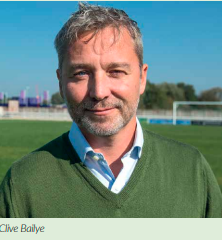
Farmer Focus – Clive Bailye
The Gross Output hamster wheel

It’s not uncommon to hear no-till farmers talk about the ‘hamster wheel’ of tillage – i.e. that cultivation creates the need for more cultivation. This continues until you jump off the wheel and make changes, including those to your rotation and agronomy, breaking the bond that links tillage to growing successful, consistent crops. There is, however, another and often not so widely considered catch 22 that has become the normal in UK agriculture, and it is a massive barrier for any farmer considering changing their farming system. I’m talking about the need, or even the addiction, to farm for maximum output and gross margin at all costs.
It is something that has slowly but surely turned many UK farms into the financially unsustainable, subsidy dependant businesses that they are today. I don’t think its accidental either. A generation or more of farmers have been sold this gross output myth by those that supply them with inputs and machinery that promise bigger yield or greater efficiency. They fund trials, shows and advertising that always has the same message, “grow more” “do more” “increase output” and you will be better off. As farmers we need to ask ourselves who does this really benefit? The maximum gross output treadmill means management and cropping decisions must be based around generating as much cashflow as possible, rotation must be dominated by high gross margin crops like all autumn planted wheat and rape which also demand early input spend.
Fixed costs should be spread over the largest possible areas, biggest possible machines and lowest possible number of people. Often ridiculous levels of rent or cut-price contract farming deals become justified in such systems as it’s all about spreading costs further and increasing that gross output the business now needs because it has rent to pay and machinery loans to cover. Having as much to sell as possible becomes more important than the cost of achieving that output. Many farms seem to have lost sight of costs, and the profit they make before subsidy.
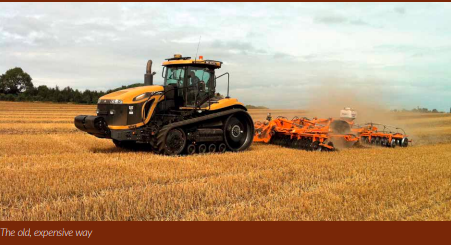
A business can be unprofitable for years and still survive, especially if like many farm businesses it has the ability to borrow money. However any business will only ever run out of cash once and that’s the day the farm sale signs get put up. This is the trap than many now find themselves in, where cashflow is more important than profit, yet surely long term ignoring profitability creates a somewhat fundamental problem and the hole being dug though increasing borrowings simply gets deeper. Gross output of a business and gross margin of crops shouldn’t be confused. “Yield is king” is an often-heard mantra and one that is to a great extent very true.
If you are committed to grow a crop you need to maximise its gross margin and any input that offers a margin over its cost is justifiable and surely the right thing to do. I have never thought of zerotill / conservation agriculture as a lower gross margin system, and I still farm fairly conventionally in terms of variety and crop protection product choice, and my aim is to get the best yield my soils are realistically capable of every year. Anything that can prove a MOIC is used here, it is not about low input producing low outputs of individual crops as is often assumed, but the aim in my system is always maximum margin.
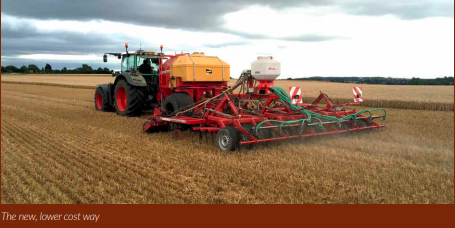
So much focus is placed on variable costs and crop gross margins yet debating the pro’s and cons of one fungicide vs another as farmers often do is neither here nor there in the bigger picture and is really tinkering while Rome burns. Making a few inputs savings is unlikely to transform many farm business fortunes. But just maybe a radical restructure of the fixed costs might be the way to finally jump off that gross output hamster wheel? Many assume moving to zero tillage will bring significant inroads into the structure of fixed costs.
Yet it’s not as simple as dashing out and buying a shiny no-till drill. In fact in isolation that’s probably just going to make things worse! Farmers often don’t need much of an excuse to jump on the latest trend if it involves new machinery but in zero-till the drill is one of the last pieces of a complex jigsaw that needs consideration. Change starts with rotation, the cornerstone of any successful zero-till farming system. Less autumn cropping of high output crops like Rape and Wheat will usually mean a drop in farm output – but this shifting of work away from the bottle-neck of autumn to a more even spread of field work between harvest and spring will make a serious reduction in the amount of power, machinery and people required to get the work done. It can double the area you can cover with existing resources, or halve the size (and cost) of what you have. Either way the fixed costs per acre will fall dramatically as a result. Spring crops tend to be far less input hungry and use less nitrogen.
Their output is lower, but growing costs are also much smaller and the length of time your cash is out in the field vs in the bank is shorter as well. Agronomically they bring an opportunity to use different spectrum and timings of herbicides helping with potential resistance and grassweed issues. It also creates a chance for over winter cover crops to be grown, capturing sunlight, water and nutrition that might otherwise be wastefully disappearing down your drains whilst feeding essential soil biology and building soil organic matter levels. The value of these things is not only financial but also environmental, the habitat it creates for wildlife is obvious as are the bigger issues such as carbon capture and a reduction in soil erosion and water pollution etc. It seems that the government and environmental lobbies are increasingly aware that farmers are in the best position to improve this situation, so it could well form the foundation of future support schemes.
This return to a “proper” rotation is the big important first step to increasing soil health and dependency on bags and bottles which leads to better yields at lower costs. But more significantly it’s the key to the reduced power, labour and mechanisation that are involved in zero- till vs tillage systems.
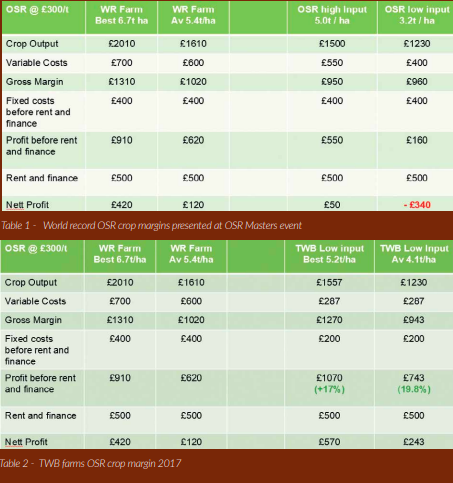
Looking at my own farm and accounts when we ran a min-till system we were using 32L/ha of fuel at establishment, today that figure is 4L /ha – 32L is what we now use from stubble to stubble! Labour has halved from 1 man /1000ac to 1 man /2000ac, wearing metal costs are almost insignificant vs their historic levels and most importantly of all the capital tied up in machinery has more than halved as well. This has removed a huge amount of depreciation and finance from our accounts and freed up capital for other investment. My costs have fallen dramatically, my gross margins are improved as we grow better higher yielding crops these days. However the lower output spring crops have reduced gross output, but with far lower costs to finance I’m far less dependent on cash flow and far freer to focus on maximising profit.
I am watching the ADAS YEN program with great interest and am in awe of the yields some achieve, they push boundaries to new levels and break world records along the way in some cases. To me its farming’s equivalent of watching a drag racing car, an impressive sight but not really something you want to be doing yourself unless you have very deep pockets ! I was recently shown the numbers behind the 2017 OSR world record presented at a “OSR Masters” event (Table 1). They demonstrate perfectly the maximum gross output approach – extraordinary yield yet despite the matching eye-watering variable cost spend, the proof is there of high gross margin. The message is clear, spending pays, and gross output is what successful and profitable farming is all about ………
Or is it! I decided to compare my 2017 OSR crop (table 2) against this shining example of profitable farming (table 2) and the numbers start to question this established wisdom. 2017 was admittedly a very good year for OSR here although it’s not unusual, we see quite respectable yields since our move to zero-till reduced the crop frequency within our now far more diverse rotation. Our highest yield was a barn busting 5.1 t/ha on a 11ac field which included headlands etc (unlike the WR crop rules allow). In stark contrast to the world record crop however this was achieved with a miserly £287/ha of variable costs spend. But yield is clearly king as despite the extra spend the gross margin of the WR crop is the winner here at some £40/ ha better than my best.
This story doesn’t end there however, gross margin is not profit and, once the significantly lower fixed costs of a zero till farm have been covered, the lower output crop is generating nearly 20% more profit! But is this really a fair comparison? My light land, low fertility grade 2/3 soil, midland based farm vs a World beating fertile, heavy land benefiting from longer northern day length and clearly technically very competent farmer? If I decided to play the world record yield game there is no way I could produce those kind of yields no matter what I spent, my soils simply don’t have that in them, so I thought it would be interesting to run some comparisons to my rolling average yields from the last 5 seasons vs the previous 5 seasons (table 3)
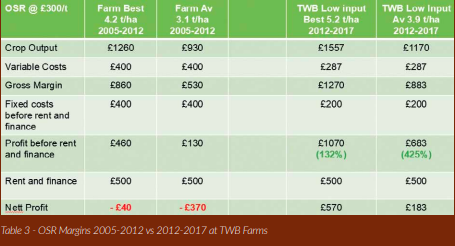
This is where things get interesting. It’s clear that using the OSR masters £300/t commodity price and a £500 rent and finance figure for consistency throughout these tables that even my best yields under our old fixed cost structure and variable cost spend was losing money before subsidy. In stark contrast today the lower fixed cost structure and VC spend is generating respectable profit. The business on the right of table 3 is one that is subsidy dependant and, like a desperate gambler at a roulette table, is stuck in a cycle of chasing losses by spinning the wheel again, filling in the gap through borrowing or taking on more land at any cost to try and dilute those fixed costs. The business on the left of that table however is healthy, sustainable, much lower risk, not subsidy dependant, but most importantly…. profitable! www.twbfarms.co.uk
-
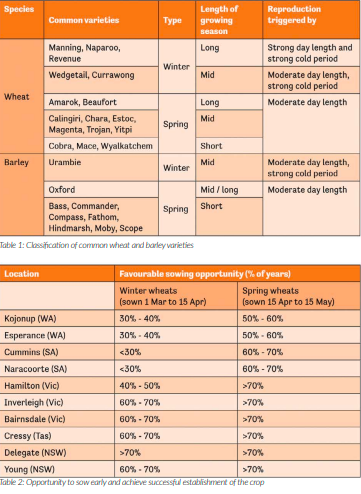
Quantifying The Whole Farm Benefits From Grazing Crops
Many farmers have commented that the greatest benefit from grazing their winter crops has been the additional pasture grown which can then be used by livestock at a later stage. This deferment requires the additional pasture production and better livestock condition from grazing the crop to be valued.
The GrassGro model was used to calculate the whole farm benefits from grazing crops for a prime lamb/ cropping enterprise in South West Victoria. Ewes were stocked at 9/ ha, lambed on August 1, with lambs sold on March 15. The modelling used 48 years of historic climatic data (from 1961 to 2006) and was able to capture the obvious benefits such as increased pasture production as well as the subtle benefits of increased reproductive performance and better lamb growth in spring because of the extra feed available. The grazing period was 4 weeks. All livestock were ‘grazed’ on crops while the pasture was spelled3. At the end of the crop grazing period, all animals returned to the pasture. It was assumed there was no loss in grain yield due to grazing.
The key findings were:
• Grazing for a month in June resulted in an extra 200 kg/ha of pasture by August 1 compared to no grazing
• Deferring the start of grazing until July but then grazing for a month resulted in an extra 260 kg/ha of pasture by August 1
• The probability of lambs reaching the target weight of 45 kg liveweight by March 15 increased by 11%
• The economic benefit was $16/ ha for the June deferment and $53/ha for the July deferment.
To enable full deferment for a month in July, it is estimated that half the farm would need to be in crop and be used for grazing. More crop would be required with a June grazing.
Further MIDAS computer modelling the Central Wheatbelt and South Coast of Western Australia showed that grazing crops also has the potential to improve farm profit by providing additional feed in midwinter, but achieving the potential benefits relied on increasing stocking rates and supplementary feeding at times to levels that might be considered extreme by some farmers. The analysis also showed higher levels of crop dry matter substantially increases the profitability of grazing crops, whilst small yield penalties of around 10% as a result of grazing rapidly eroded most of the benefits.
What and how to do it (agronomy at the paddock scale)
Successful grazing of crops requires the production of useful amounts of dry matter soon after sowing, with the ability for the plants to recover dry matter quickly after grazing. To maximise the chances of realising this, the following needs to be considered.
Paddock selection
Choose paddocks that provide early sowing opportunities. These are likely to be paddocks that:
• Are low in weeds. Paddocks with low weed densities can be sown earlier because there is no need to wait for a germination and kill before sowing. Heavy weed burdens compete with the crop for moisture, reducing early dry matter production and compete against the crops as it recovers from grazing. Furthermore, grazing will open up the crop canopy letting light between rows and favouring weed growth after grazing.
• Wet up sufficiently after early rain to allow for an even germination of the crop and for subsoil moisture to be retained. Stored soil moisture is often vital to maintain crop survival if adequate follow up rains fail to occur.
• Have good soil fertility. Adequate phosphorus and nitrogen will provide opportunity for rapid leaf growth. Paddocks that are likely to have favourable mineralised nitrogen from a previous season are desirable. A crop with adequate nutrition will also recover faster after grazing.
• Low disease status. Early sowing in warmer conditions can often exacerbate underlying disease problems.
What to sow
Dual purpose or winter wheats immediately come to mind when thinking about crops suitable for grazing. Yet both spring and winter type crops can be grazed, it is just their development and therefore management decisions such as when they are sown and grazed need to be slightly different (see side story ). There is a lot of information available about crop varieties. They are commonly grouped into winter or spring types, by the length of growing season and by their maturity pattern (early, mid, late etc). Behind these grouping is the cold period (vernalisation) and day length (photoperiod) requirements of each variety.
Varieties are constantly entering the market and it is recommended you consult with your local agronomist to ensure the variety chosen suits the time of sowing and optimum flowering time. However to help gain a broad understanding of the different classifications, some common wheat and barley varieties have been listed (table 1). While seasonal conditions have a strong influence on the amount of dry matter grown, in general barley will produce feed earlier than winter or spring wheats when sown at the same time. Spring wheats are generally faster growing than winter wheats. The amount of dry matter that triticale crops produce falls between barley and wheat.

Because all crops can be grazed, the choice variety within the broad classification becomes less important. Deciding what to sow should be primarily determined by the existing crop rotation, feed requirements and other paddock considerations rather than the variety.
When to sow (time of sowing)
Cereals crops and canola with strong winter habit can be sown early in the year (March to mid-April) because they need a period of cold and short days before they will run to head. Earlier sowing combined with favourable weather conditions can result in large amounts of dry matter for grazing. Spring varieties sown early, even including long season types, will flower too early leaving the crop vulnerable to frost damage. For these varieties a mid to late April sowing is recommended. Short season spring varieties need to be sown even later, at the more conventional May sowing time.

Moisture for successful establishment Successful early sowing obviously requires good establishment and subsequent growth. A recent study by the CSIRO5 examined the probability of successfully establishing winter habit crops early in the season (1 March to 15 April) and earlier sown spring habit crops (15 April to 15 May) in the higher rainfall zones across Southern and Western Australia. As expected the chances of successful establishment varied considerably across the country and improved with later sowing (table 2).

Growth after establishment
The amount of dry matter produced from early sowing, even with successful establishment, is dependent on adequate stored soil moisture or follow up rain. Figures 1 and 2 present dry matter production from early sown trials over a range of years. Results have been adjusted to indicate the average dry matter produced at the start of June and the start of July. Additional factors beyond time of sowing and variety selection also need to be considered when deciding on when to sow. These include issues around weed control and potential for increased crop disease.
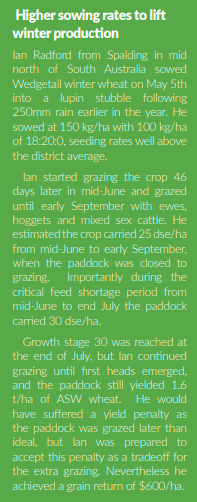
Options for increasing dry matter production up to growth stage 30
Apart from early sowing, the most common approach to increase dry matter production for grazing is by increasing sowing rate (see side story). Trials from both high and low rainfall zones illustrates the potential benefit from higher sowing rates if seasonal conditions are favourable (table 3). If conditions are unfavourable, higher seeding rates have limited value.

-
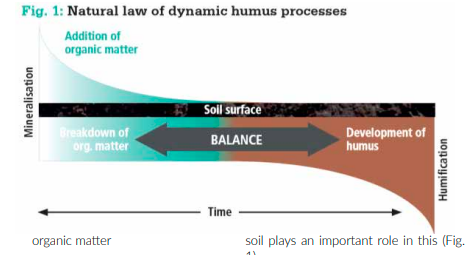
Humus – Black Gold
Written by Christoph Felgentreu, Jan Hendrik Schulz · Bückwitz from DSV
Farmers have a choice as to which ecological compensation measures they use to meet their greening obligations.
According to the German Federal Ministry of Food and Agriculture (BMEL), around 1.37 million hectares of land were
designated as ecological focus areas in 2015, of which as much as 930,000 hectares were undersown or sown with cover crops. In weighted terms (factor 0.3) this amounts to around 40 % of all greening measures undertaken.Such widespread use of cover crops or undersowing is unsurprising given the fact that soil fertility, biodiversity and crop rotation have long since become a key part of modern, innovative farming practices on many farms. In this context, we often refer to the humus balance and humification. Cover crops and undersowing are ascribed a humus equivalent of up to 450 kg C/ha/year. In arithmetic terms, therefore, this allows so-called “humus consumers” to be compensated for and enables farmers to meet the requirements of cross compliant farming. This is the arithmetic side, however, and should only be of interest to the farmer from this point of view; after all, it is the biological aspect that is more important for the farmer. Humus is an important store of water and nutrients – especially in arid regions – which also improves the physical and biological properties of the soil. Whether and how much of the added organic matter actually becomes nutrient humus or stable humus depends on many different factors.
The most important factors
• Location (region/soil conditions/soil type)
• Climate/weather conditions
• pH value
• Method and frequency of soil cultivation (oxygenation)
• Use of nitrogen fertilisers, depending on the form of nitrogen (mineral) and type of application (mineral and organic)
• The soil’s current biological status
• Nutritional balance in the soil
• Quantity and quality of added organic matter
• C:N ratio of organic matter
• Crop rotation

These 10 factors alone clearly demonstrate that deskwork is not the only way to establish humification. To illustrate this, let us take a closer look at some of these influencing factors. In the past, too little attention has been paid to the significance of the C:N ratio in the soil and in the organic raw materials needed for humification. The C:N ratio in arable land is generally around 10:1. Assuming a dry bulk density of 1.5 g/ cm3 and 30 cm topsoil, that amounts to 4,500 t soil/ha. Assuming the soil contains 3 % organic matter (humus), that comes to 135,000 kg/ha. The conversion factor (mean) for carbon (Corg) is 0.58, so the arithmetical carbon content is 78,300 kg/ha. At a C:N ratio of 10:1, there is therefore 7,830 kg N stored in the soil. This in turn means that approximately 2,600 kg N/ha would be needed to increase the humus content in our model soil by just 1%. This example shows not only that increasing the humus content depends on a large number of long-term dynamic factors, but also that the nitrogen cycle in the soil plays an important role in this (Fig. 1)

There are two questions to be answered:
1. What are the most favourable conditions for humification?
2. Where do I get the additional nitrogen from?
To answer both these questions, we need to look at the C:N ratio of added organic matter. The organisms primarily responsible for humification processes are fungi and bacteria. Bacteria prefer a lower C:N ratio (< 15:1) while fungi prefer a higher ratio (> 15:1). However, the ideal C:N ratio for humus-forming processes is 24:1, which very much favours fungi (source: USDA, 2013). Bacteria often use nitrogen compounds as a source of energy and oxygen.

Fungi, on the other hand, are generally dependent on plant matter for energy. Many fungi use the lipids (waxes) that form as dead material decomposes as a source of energy. These can usually only be digested by fungi (with the exception of organisms such as actinomycetes), and this process is one of the key aspects in the formation of humic acids and humic substances and therefore in humification. Actinomycetes are a type of bacteria that play an important role in the conversion of organic matter to humic substances. For a long time they were classed as fungi since, like fungi, they are not only filamentous in habit but also behave similarly in many ways. Some break down harmful substances, provide pathogen resistance and the typical fresh smell of the soil, are highly efficient at decomposing cellulose and lignin, and prefer a high C:N ratio. If food is in short supply, actinomycetes can also break down humus, so it is important to ensure a constant supply of nutrients. This partial dependency of actinomycetes on cellulose and lignin raises the issue of straw compensation fertilisation with nitrogen or mineral or nitrogen-containing organic fertilisers (see Table 1).

In certain circumstances, reducing the C:N ratio can encourage bacteria that are detrimental to humus formation and speed up the breakdown of straw – something that was seen as desirable in the past. If the straw is incorporated without nitrogen compensation, it binds nitrogen from the soil pool, which can cause significant problems in the next crop, such as lower yields and a drop in quality. This Gordian knot can be solved by leaving the straw on the surface and sowing the seeds below the straw using suitable drilling techniques (no-till or low-depth reduced tillage).
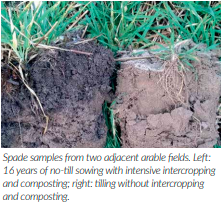
Another advantage is that this reduces the likelihood of excessive oxygenation. If N fertiliser (mineral or organic) is then applied locally, it will not only be possible to achieve an ideal C:N ratio in the organic matter but also to lessen the influence of the nitrogen on the soil biology. The latter is in turn important when it comes to the additional nitrogen that is essential for humification (promoting nitrogen-fixing bacteria such as Azotobacter). Legumes are undisputedly the most important source of nitrogen. Depending on the species and their use, they can form up to 500 kg N/ha/year. Crucially, it is important to ensure that any excess nitrogen that is developed by leguminous crops is used to promote the formation of humus.
In almost all crops, undersowing with grass is an ideal way of fixing stray nitrogen on the one hand and boosting the C:N ratio on the other. In traditional intercropping, this is achieved by combining legumes with non-legumes. Table 2 very clearly shows the importance of intercropping and crop rotation for the development of soil microbiology. A further promising source of nitrogen for the future is another group of bacteria called Azoarcus. The results of initial trials in maize at our Bückwitz site show that on average over four trial years, around 60 kg N could be attributed to the Azoarcus bacteria with which the maize was inoculated compared to the control with no N.
Conclusion
The conversion of organic matter to humus is a very complex process. The challenge lies in balancing mineralisation, humification and yield. Providing the added organic matter has the optimum C:N ratio for the accumulating microbiological processes of around 24/1 and natural sources of nitrogen can be exploited while reducing tillage and applying nitrogen fertilisation locally, it should be possible for humus to build up if good practice is followed.
-
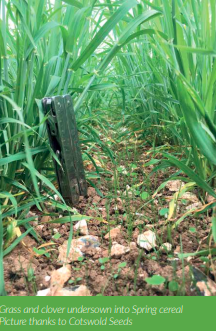
Getting To Grips With Companion Planting
Growing different plants next to each other, in the same field or plot, is alien to many farmers but less so for ‘growers’. Farmers who talk to their neighbours with gardens may well find they have been growing combinations of crops for decades. The world of horticulture knows that marigolds create natural pesticides that keep nematodes and beetles off tomatoes, asparagus and squashes. That growing beans, which fix N, helps maize, brassicas and beet along. Horticulture has tended to be wary of chemical controls, both from the cost and a natural leaning towards organic methods.
Farmers on the other hand have mainly taken the route of a single crop which can be managed through pesticides and fertilisers. With professional agronomic advice the system has been universally adopted and experience and knowledge has been developed which enable there to be calculable costs and predictable effects. Farmers are moving from conventional chemical methods to those based on biology. Effectiveness; cost; product resistance; soil condition; chemical runoff; negative environmental issues are just some of the drivers.
Companion cropping has become one of the ‘go-to’ farming systems favoured by advisors and others as being good for the environment and soils. Yet little has been recently published on the topic – by far the most comprehensive comes from Kentish farmer Andrew Howard whose Nuffield Farming Scholarships Trust Report of July 2016 ‘The potential for companion intercropping on UK arable farms’ takes a global look at it. It provides a substantial introduction to intercropping and guidance for UK arable farmers to help encourage onfarm experimentation. With a rise in the prevalence of weed, insect and disease resistance brought on by monocultures and high-input farming, intercropping can help farmers grow crops with lower inputs. The report makes the case for its potential to regenerate degraded soils and increase productivity for arable systems increasingly reliant on external inputs.

In his report Andrew explains that the impetus to apply for a Nuffield Scholarship came from his friend Tom Sewell who in 2013 was in the middle of doing one. Andrew found the idea of travelling the world and meeting the best farmers on the planet ‘strangely appealing’. The previous year he had been to a meeting where a French farmer, Frederic Thomas, was speaking. He talked about No-till and cover crops and then at the end of his talk he spoke about companion cropping with oilseed rape. This seemed like a crazy idea but got Andrew to experiment on the family farm. It worked so well he became hooked, and realised he had a useful topic for his Nuffield Farming Scholarship.
The study took in five separate trips: the first, May 2015, to France, chosen for their similar climate plus the fact they “ahead of us in terms on companion cropping and intercropping research and on-farm practices.” The second, JuneJuly 2015, was four weeks in the USA and Canada. The third, November 2015, was to Germany, Switzerland and France, and the fourth was 7 days in Kenya and another 10 in South Africa. Finally in June he had three days in Sweden and two in Denmark, with a particular interest in seeing how it works with their strict environmental laws, which Andrew sees as being applied in the UK before too long.
‘Companion Cropping’ has a wide meaning and Andrew needed to work to a closer definition which he describes as:
“The growing of two or more crop species where part or all of their crop cycle overlaps temporally and/or spatially, where one or more of the component species is taken to harvest”
He then found that rather than being new, the technique was a regular part of farming until mono-cropping became the norm.
• In 1923 57% of Ohio’s soya bean acreage was intercropped with maize
• In 1972 98% of cowpeas in Africa were intercropped with maize
• In 1975 90% of beans in Columbia were intercropped.
And the history goes back 5000 years to native Americans who grew maize, beans and squash together, the beans fixing N for the maize and using it as a trellis, and the squash grew low and shaded out the weeds. When different species like each other they over-yield – produce more than they would in monoculture. The figures are considerable: conventional farmers in Canada will experience over-yielding in intercropping in 75% of instances, while over-yielding occurred 47% of the time in organic crops. Inter-cropping performance is measured, often using the following formula:
LER = (Mixed yield 1 / pure yield 1) + (mixed yield 2 / pure yield 2)
where LER is the Land Equivalent Ratio, or the amount of land it would need to grow the two crops separately. When LER is greater than 1, then there’s a yield advantage, but not of course necessarily more profitable. So the calculation is made for the Relative Total Value, the Monetary Equivalence Value or the Income Equivalence Value.
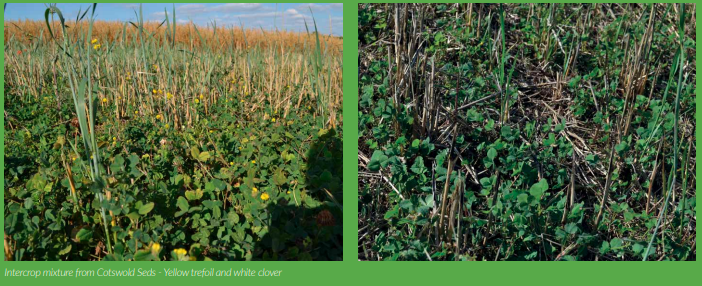
He found farmers experienced both benefits and drawbacks of mixing plant species. The benefits are the way combining species increases the resistance of thee crop as a whole to pests and pathogens Ian Wilkinson was persuaded to use companion cropping after meeting Nim Barnes who ran a charity called Foresight. “You are an agriculturalist,” she said, “have you thought about the minerals in your diet?” We hadn’t. “You analyse plant tissues,” said Nim, “so analyse yourselves!” We did, and we found that we were deficient in many minerals.
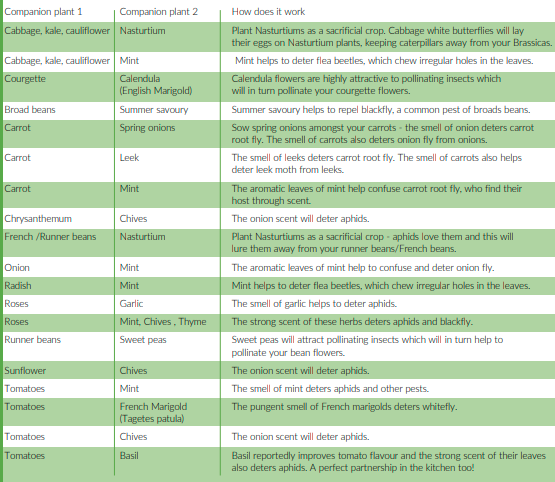
Ian found that over 50 year period there has been a falling levels of minerals in milk, meat and vegetables as production has become increasing intensive, and at the same time herbs and deep rooting legumes have been ignored. He bought into the idea of raising mineral availability by using these unfashionable plants to mine minerals through livestock and cover cropping. Ian’s expertise of crops comes through his position as MD of Cotswold Seeds. In 2013 he bought a 107 acre Cotswold farm, mostly made up of brash and which produced an annual crop of spring malting barley. The farm now has deep rooting leys as a break, using nurse crops and inter crops, undersowing clover to wheat, and rye and vetches as winter green manure. Instead of the land being bare for much of the year, the aim now is to keep it covered, and with mixed species.
Sheep are brought in to do some mob grazing which is providing a youngster the opportunity to build a flock, and at the same time make major improvements to soil quality. Ian says the ultimate companion crop is a diverse herbal ley which works well when mob grazed, which makes it more palatable, so intakes are higher. With better protein there’s greater lightweight gain and more milk. Sanfoin is the winner in Ian’s eyes. The diverse deep rooting ley is its drought resistance. Ryegrass, with its shallow roots, stops growing in a drought while thee deep rooting ley keeps going. Companion crapping is as vital as cropping, and Ian has fund the sheep have done wonders on his Cotswold farm. The trick is to integrate livestock with the arable acreage.
Tips from horticulturalists
Sue Sanderson from Thompson-Morgan says that companion planting is all about creating communities which have mutual benefits for each other. The benefits can be pest control, or improved pollination of fruit and vegetables. Intercropping, where fast growing crops like lettuce or radish are sown between wide rows of Sprouts or parsnips makes good use of space and suppresses weeds. Tall plants like peas and sweet corn create shaded conditions which prevent crops like lettuce, coriander and spinach from bolting. Most herbs have scented leaves that help repel insects. Others attract insects and birds and these can be useful in drawing in natural predators which feed on slugs, hover flies and other pests which they like eating. Not all species are good companions, however, and the advice is never grow these plants side by side: Alliums (onions, shallots, leeks, garlic) with legumes (peas, beans, peanuts). Tomorrow’s agronomist will need knowledge not only of chemical products but also of companion cropping. And so the wheel turns full circle!
Mike Donovan
-

Farmer Focus – Steve Lear
It’s called a fools spring for a reason….

The dry winter has meant that we have been able to get the first round of fertilizer out onto cereal crops this year nice and early. The wheats and barleys are looking a picture and are still tillering out nicely. The disease pressure looks low so far apart from a few patches here and there. We have a small amount of herbicide to apply to the earlier drilled wheat but in general the blackgrass situation looks good compared to a year ago. I think this is due to the ability to direct drill late last autumn. The warm temperature at the end of February has pushed the crops on nicely and brought soil temperatures up early this year. We have drilled a little bit of land for a few customers who are on cleaner ground than we are, but I am yet to start our own. I’ve always believed that the main reason we use spring crops is to help with weed control. If we go drilling early in the spring it can undo the benefits of spring drilling on heavy soils. The old fellas call it a fools spring for a reason round here.

We have had to right off 80 acres of winter beans due to crows ravaging the crop as it emerged in late November. It was drilled into a grass ley and went in beautifully. I think the crows may have been eating grubs and worms out of the sprayed off pasture before we drilled and as the beans came through they had a go at crow Veganuary and moved from grubs too beans. A few fields away we had beans established under a cover crop which hasn’t been touched by the crafty corvid invaders. It may become our policy to use cover crops in front of beans in the future. We are also trialling a few ways to make better use of our fertilizers. I’m using some CAN this year on the heavier land after reading an article in the previous edition of Direct Driller about calcium requirement. Our heavy ground doesn’t have a large amount of calcium in it and we have probably neglected the calcium requirement for crops in recent years. We also found that it was a considerably cheaper nitrogen supply than purchasing straight AN which was a nice bonus..
On top of this I have put in a few trials using humic acid and fulvic acid. The humic acid has been used in conjunction with digestate on our grass leys. I will also try some in the spring crops this year. The idea of this is to improve the cation exchange capacity in the soil to prevent wastage of nutrients. I’m told it will also help to break clay down and make it more friable, help retain moisture and feed microbial life. The fulvic acid will be added to each pass of liquid fertilizer. The hope is that using the two together we will make more efficient use of our fertilizers. The products that I am trialling are from Susan Wilson at Aphaeas Agriculture, I’ll keep you all posted how the trials go. I know a lot of farmers have mixed feeling about using digestates on land.
We have decided to use it primarily on grassland at low dose rates (20cu/ ha). From the research I have seen this doesn’t have a measurable effect on the worm populations and microbial life in the soil. Hopefully adding in the humic acid may even help encourage the soil life. I believe that grassland has a better ability to recover from applications of digestate compared to arable soils. Bio stimulants and foliar feeding a crop are also on our radar. We used some last year with good success and will be using a lot more this year. The product we have used is called ‘universal bio’ from Yara and contains essential nutrients (some chelated) and a seaweed extract. It is a great foliar feed and has shown promising results in trials. We certainly saw a benefit from it in the drought last year. We will add a small amount to every fungicide pass this year.
Some of you may have read that we have been composting our manure from our beef herd. I am comparing the composted manure against manure straight out of our sheds. The parts of the fields that have had the composted manure are currently looking like they have tillered out better and are a slight shade greener when compared to the un-composted manure areas. It will be interesting to find out if this is purely visual or will have an impact on yield at harvest time. Things are looking good for our first year fully in no-till.
-
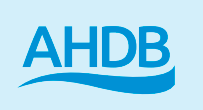
Following The Slug Trail
AHDB’s Crop Protection Scientist, Charlotte Rowley, assesses new methods of control against slugs in the face of the
industry losing metaldehyde.
Following the announcement from Defra on the withdrawal of metaldehyde in 2020, thoughts are again turning towards slug management. The good news is that there is an effective alternative: ferric phosphate has been shown to be as effective as metaldehyde in controlling slugs. Unlike metaldehyde, slugs die underground rather than on the surface, meaning it may not be as obvious when an application has been effective. The bigger issue, apart from differences in product cost, is that relying on only one active ingredient leaves the industry in a vulnerable position when it comes to slug management. Now more than ever it is important to use every tool in the armoury to ensure that molluscicide applications are kept to a minimum.
Using cultivation as a control
Cultivation is generally regarded as one of the more effective forms of cultural control, therefore no-till farmers may be more concerned than most. It’s important to remember though that there is no silver bullet for slug management, and a whole system approach is needed. So while cultivation is bad news for slugs, it can also be bad news for predatory ground beetles that help keep slug populations in check. Ground beetles, as the name suggests, forage and hunt for their food on the soil surface and have soil dwelling larvae, and therefore tend to be vulnerable to soil disturbance. Keeping pesticide use to a bare minimum and providing habitat in the form of diverse field margins will also help maintain numbers of these beetles and other natural enemies.
Cover crops have a role to play
Cover crops can provide much needed habitat for beneficial insects, however they have a bad reputation when it comes to slugs. It is often reported that cover crops make slug damage worse, creating a sheltered, moist, food-rich habitat that slugs love. However, research suggests that the type of cover crop can make a huge difference when it comes to slug pressure, with some crops such as ryegrass thought to be less attractive to slugs due to the high silicone content of the leaves. There are other insects too that are benefitted by increasing plant diversity, and while they may not feed on slugs directly, they provide food to support populations of slug-eating birds and carabids.
What can the farmer do to help?
However, as helpful as they are ground beetles cannot do all of the hard work. This is where farmer intervention is needed to get the crop off to a good start. A fine, consolidated seedbed (e.g. through rolling) means that the seed is more inaccessible to slugs and helps get the crop established and able to grow away from damage. Anecdotally, some farmers have had success protecting their wheat from seed hollowing by sowing it directly into the stubble of the previous oilseed rape crop, allowing the volunteers to act as a trap crop until the wheat is no longer vulnerable to attack. Other farmers report that raking of straw and crop debris can reduce the risks of slug damage in minor no-till environments. This might work by exposing slugs and their eggs to the sunlight, drying them out and making them more accessible to predators, as well as reducing the number of damp hiding places on the soil surface.
What we know and what happens next?
As for oilseed rape crops, we know from work on cabbage stem flea beetle that the plants can be extremely resilient to damage and establishment is key. A DEFRA-funded desk study done by ADAS in 2014 suggested that for OSR sown at 60 seeds/m2 a single dose of metaldehyde only became cost effective at moderate slug pressures (where 30- 50% of plants were expected to be lost). Where pellets are more expensive (as with ferric phosphate) or slug pressure is lower, it might make more economic sense to instead increase seed rate to mitigate against slug damage. While this doesn’t take into account further losses from e.g. pigeon damage, it demonstrates the ability of the crop to compensate for losses. Unfortunately for farmers, slugs tend to congregate in patches which can lead to an uneven distribution of damage, making crop compensation less effective.
AHDB PhD student Emily Forbes, at Harper Adams University, has been modelling these patches in the hope that this will lead to the ability to target control options more effectively. “My PhD project has identified and confirmed the potential for patch treatment of slugs” said Emily, “further work is required to refine the methods for locating the patches without the requirement for trapping in order to make the findings commercially viable”. Her report, due this spring, will shed light on some of the slug behaviours leading to patch formation. Other research to look out for this year will be from AHDB’s Nuffield scholar Jenna Ross who has been travelling the world learning about slug and snail management in other countries, in a range of agricultural and horticultural systems. Both of these projects will help push towards improving or increasing the current range of control strategies which will be essential if we are to have effective and sustainable slug management in the future.
For further information, please visit:
cereals.ahdb.org.uk/crop-management/
pest-management.aspxOr to download our slug control factsheet: ahdb.org.uk/knowledgelibrary/integrated-slug-control
KEY SLUG SPECIES
The grey field slug (Deroceras reticulatum) and other Deroceras spp.
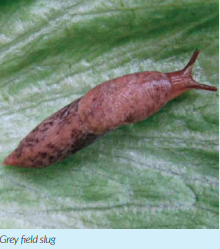
The grey field slug is the most widespread and troublesome species. It is usually light grey or brown, grows to 5 cm in length and produces milky white mucus. Populations tend to have a mixed age structure, so damage occurs whenever conditions are favourable for activity. It continues to be active in damp weather and even when temperatures are close to freezing. Breeding is generally at a peak in April and May and then again from September to October. However, in favourable conditions, it will breed throughout the year. In optimum conditions it can start to lay eggs within 16 weeks of hatching.
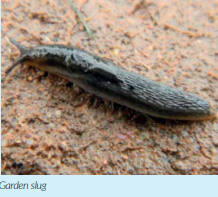
The garden slug (Arion hortensis and Arion distinctus)
The garden slug is usually smaller than the grey field slug, growing to 3 cm in length. The body is dark and the foot (underside) ranges from yellow to orange. It produces orange or yellow mucus. Egg hatching reaches its peak in late spring/early summer. Young slugs can develop rapidly to produce a further generation within the year. Arion species are only active at temperatures above 5°C and are less active on the soil surface than the grey field slug.

The keeled slug (Milax,Tandonia and Boettgerilla spp.)
Keeled slugs are more localised in arable crops than field or garden slugs but they can be important. They vary in size and generally produce a colourless mucus. Keeled slugs have annual life cycles, with eggs hatching from autumn to spring. All keeled species are generally subterranean but can be seen on the surface, especially during the breeding season.
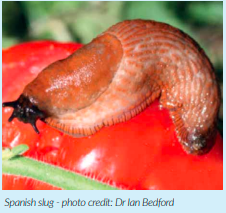
The Spanish slug (Arion vulgaris)
Spanish slugs can be brown, black, fawn or mustard coloured and can grow up to 15 cm long. Unlike other slug species, the Spanish slug is omnivorous, eating dead animals, excrement and plant material. They produce twice as many eggs as native slug species.
LIFE CYCLE
All slug species are hermaphrodite (each individual is both male and female). While some species are self-fertile, most mate before laying eggs in batches of 10 to 50 in soil cavities, between clods, under stones or at the base of plants. Up to 500 eggs per slug may be laid over several weeks. Eggs develop slowly in the winter but will hatch within a few weeks when the temperature starts to rise. The number of active slugs found at any one time and place is dictated by both the slug population density and the suitability of the weather for activity (activity-density). Rapid reproduction and growth is enhanced by mild, moist weather conditions, sufficient food supply and ample shelter. Such conditions prevail in the spring and early autumn, making crops like lettuce and Brassicas more vulnerable at these times of year. Slug movement occurs most frequently at night but they will return to their resting site by dawn if weather conditions are unfavourable. They do not travel far from where they were hatched, often taking only a circular route of a few metres in search of food..
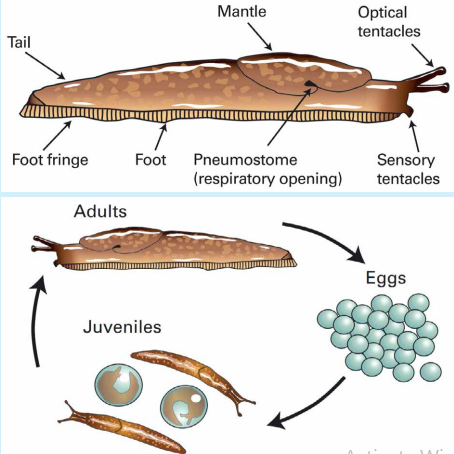
MONITORING FOR SLUGS
To assess the risk of crop damage, it is important to estimate the size of slug populations present. Sampling in the field is best done using refuge traps. Put slug traps out before cultivation, when the soil surface is visibly moist and the weather is mild (5–25°C). When soil conditions are dry and slugs are not actively seeking food, trapping will have little value in determining the threat to the crop. Traps consist of a cover about 25 cm across, such as a plant pot saucer, with a small heap of bait underneath.

A suitable bait would be two heaped spoonfuls of chicken layers’ mash or a cereal grain-based food (NOT slug pellets). Leave a small gap between the trap and the soil to allow slugs to enter. It may be necessary to put a weight on the trap in windy conditions. In each field, nine traps (13 in fields larger than 20 ha) should be set out in a ‘W’ pattern spread over the entire area of the field. Also, concentrate on areas known to suffer damage. In standing crops, place the traps just to the side of tramlines and mark with canes to allow them to be located.

Leave traps overnight and examine early the following morning while the soil surface is still moist, counting the number of slugs present and noting any slime trails. On warm days, it is important to check the traps early while the temperature is still cool, as slugs will leave the trap as it gets warmer. If no slugs are found, continue to trap until crops have passed their vulnerable stage. The following (Table 1) thresholds indicate a possible risk when soil and weather conditions favour slug activity.
-
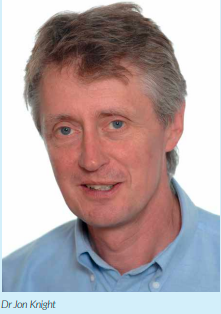
Why Integrated Pest Management Is Closer Than We Think
Dr Jon Knight, AHDB Head of Crop Protection assesses the shifting political emphasis on environmental protection and the future for Integrated Pest Management
What is Integrated Pest management (IPM)?
The Food and Agriculture Organisation of the United Nations definition is as follows: Integrated Pest Management (IPM) means the careful consideration of all available pest control techniques and subsequent integration of appropriate measures that discourage the development of pest populations and keep pesticides and other interventions to levels that are economically justified and reduce or minimize risks to human health and the environment. IPM emphasises the growth of a healthy crop with the least possible disruption to agroecosystems and encourages natural pest control mechanisms. IPM has been adopted to varying degrees across most crops, cropping systems and regions of the world at different times and with different levels of success. There are now very few farmers, globally and in the UK, that do not practice at least some part of the IPM approach whether it be rotational cropping, monitoring or some other facet.
There are a number of drivers behind the need to drive wider and deeper adoption of IPM, many political but a number resulting from the long-term, widespread use of chemical control. Politically it is clear that UK government policy has shifted towards a greater emphasis on protecting the environment as exemplified by reference to IPM in the Government’s 25-year Environment Plan and reference to IPM in the Environmental Land Management Scheme (ELMS). Michael Gove and George Eustice have both said that there needs to be a greater focus on IPM and that protecting the environment is a primary aim of policy post-Brexit so the business as usual approach is unlikely to be sustainable.
The ever-evolving EU regulatory framework continues to put pressure on the availability of actives through the re-registration process, review of Maximum Residue Limits and the politicisation of what should be a purely scientific and rational process. The increasingly stringent requirement for the approval of new actives and registration of new products has led to a significant decline in new products coming to market due to finding chemicals that can comply with the regulatory requirements and the multi-million pound cost of producing the necessary data to support registration. Coupled with the rise in the number of cases of pesticide resistance in insects, weeds and diseases there is unprecedented pressure on the use of crop protection products.

It appears that one of the drivers behind all the talk around IPM is that there is an expectation that the quantity, frequency and potency of crop protection products needs to be reduced which has driven the banning of 3 neonicotinoid and many other actives. This means that the way that crop protection is delivered will have to change to more targeted, ’softer’ products that impact less on the environment. The key targets appear to be insecticides as their unintended impacts are perhaps easiest to see, although increasingly side effects of fungicides and herbicides are coming under scrutiny. Whilst new solutions need to be found there is a need to see what can be achieved by doing things differently with what we already have e.g. can we safely miss a spray from the fungicide programme? A farmer making this sort of decision requires concrete evidence to persuade them that altering programmes on the basis of better forecasting or diagnostics is a sensible thing to do and will not result in crop or financial loss. Developing new varieties that are better able to withstand the effects of pests and diseases and possibly weeds too is a key tool along with the use of soil management that can help to suppress soil borne pests and diseases.
Soil health and fertility is a fundamental part of IPM as good establishment of healthy and robust plants is key to resisting the impact of various pests. The use of min-till or zero-till can add substantially to soil health and is therefore a key tool for many, though not all, farms. There is much anecdotal evidence that certain practices effect a level of control on pests that needs to be examined closely and either confirmed to work or not. This comes down to having a better understanding of fundamentals such as the biology of the crop, the wider environment and of course the pests. The successful implementation of IPM is very knowledge intensive and farmers and advisers will need to be able to analyse information in order to develop strategies for crops both before and within the season. Any transition will therefore need a robust process of knowledge exchange and continued professional development.
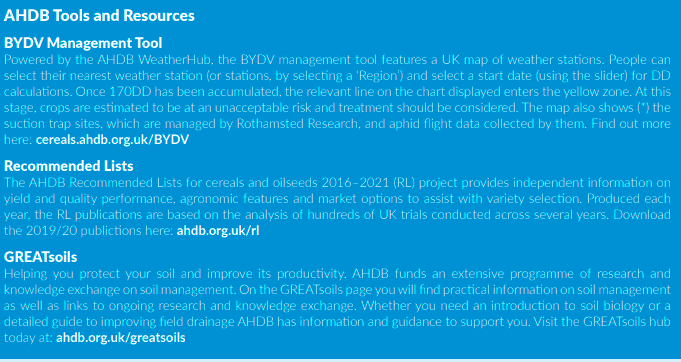
-

Drill Manufacturers In Focus…
DRILL FOR THE MODERN ERA

A seed drill that meets the needs of today’s progressive arable farmers needs to be strong, precise and, perhaps most important of all, versatile. That’s the mindset that’s been adopted by KUHN in the development of the AUROCK, which was launched at SIMA 2019 this year. Combining proven drill technologies that have served the company well for over 40 years with real innovation, the Aurock is a machine to operate effectively in the conservation agriculture environment and beyond. As KUHN UK product specialist Alex Birchall explains, conservation agriculture requires a rethink in the approach to cropping. In the same way, drill manufacturers need to tackle machine design and configuration from a fresh perspective.
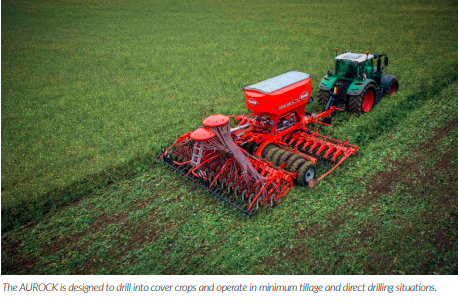
“Where ploughing is replaced by varying degrees of shallow tillage, or if establishment is to be achieved into an existing crop, the role of the drill becomes more crucial than ever to the success of the system,” he says. “KUHN has longstanding experience in drill manufacturing, including direct drills, so the development of a machine that provides solutions in the broad range of conditions seen in minimum or zero tillage situations has been a natural progression.” The AUROCK is available in a sixmetre format from the summer of 2019, with single and dual metering units. The single metering unit version (AUROCK R) has a 3,500 litre capacity hopper and the double metering unit version (AUROCK RC) has a 5,000-litre capacity split hopper. It is designed for a low horsepower requirement, needing a modest 180hp to operate.
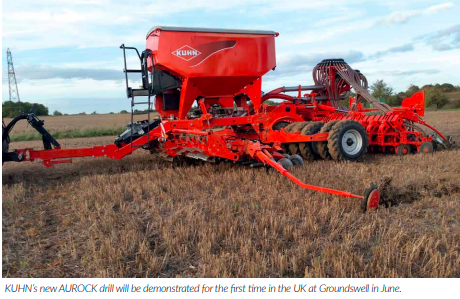
The drill’s ability to work in varying field conditions starts at the front with two rows of opening discs. There is the option of 460mm diameter corrugated discs, for working in prepared soil of soil mixing, or a 430mm diameter embossed disc for cutting residues efficiently and minimising soil ejection. Seed placement is carried out by the double-disc seeding unit mounted on a parallelogram for optimum delivery accuracy and perfect ground following. Alignment with the opening discs is maintained by a central pivot point between the coulter bar and the chassis. This ensures that seeds drop accurately into the furrow, whether the drill is operating on a slope or around a bend. The opener discs and seeding unit assembly form the triple disc that has underpinned KUHN’s success in drill manufacture for forty years.
Dual metering
Choosing the AUROCK 6000 RC dual metering option adds numerous possibilities, including dual cropping or alternate row drilling with independent management of seeding depth. These options are increasingly relevant for farmers seeking more innovative cropping solutions, whether for pest control or improving soil health. The modular design of the AUROCK allows the option of an integrated cutter roller with adjustable pressure to enable efficient operation in all cover types. The transport wheels are positioned between the opening disc and the coulter bar. The machine can also be equipped with a whole-width wheel train for seeding

within a minimum tillage cropping system. The offset press wheels prevent soil from building up at the front and amplify the versatility beyond direct seeding. They allow the passage of plant residues and reduce pull power requirement. Their large diameter of 900mm reduces rolling resistance. The AUROCK seed drill is an ISOBUS compatible machine, available with CCI 1200 or CCI 50 terminals (ISOBUS certified by the AEF). For comfort, a joystick is also available as optional equipment. Regardless of the selected control terminal, the operator has a user-friendly and intuitive interface developed specially by KUHN. A simple press of a button at the headland allows successive lifting of the front tools, then the stop of the metering unit(s), ensuring perfect seeding to the edge of the field. This ensures no seed remains on the surface, overcoming a common problem of direct seeding.
-
Stress Levels: Fighting Abiotic Stress With Amino Acid Biostimulants
Just how essential are individual amino acids in helping plants cope with environmental stress? Taking a close look at the effects of amino acid biostimulants on early root and shoot growth in winter wheat and spring barley, we explore here the role some of the key amino acids play in resilience, yield, and overall plant health.
The impact of climate change is beginning to have an adverse effect on our crops. Never was this more apparent than during the long, hot summer of 2018. In a year of unprecedented weather extremes and increased challenges to plant health, last summer was one of the hottest on record for the UK, up there with the heatwave of 1976. Alarmingly, findings in December’s Climate Predictions Report from the Met Office confirmed what many of us already suspected; the UK can expect warmer, wetter winters and hotter, drier summers, with an increase in frequency and intensity of extremes. As demand on growers and their crops becomes ever more fierce, agricultural productivity is facing threats from a variety of stress factors, many associated with global warming.
It’s clear that we need to change the way we think about crop husbandry. Crops will need to adapt to extreme weather patterns, exhibiting more resilience to a wider range of conditions than has been necessary in the past. This isn’t an issue we need to think about in the distant future; it’s affecting growers and their crops right now. We already know that environmental stress conditions can have a serious effect on plant fitness and productivity. At Interagro, we are certain that unlocking the genetic potential of plants and increasing the resilience of crops to climate change are the most pressing agricultural challenges of our time. This is where amino acid biostimulants come in.
The building blocks of all living cells, amino acids combine in infinite variations to produce various essential proteins for healthy growth and development. Under ideal conditions, plants synthesise all 18 L-amino acids they require, using carbon and oxygen in the air, hydrogen from water and nitrogen from the soil. This is what makes soil quality and nutrient density so important to overall plant health. But what happens when plants aren’t getting what they need from their environment? Used in the right way, amino acid biostimulants help optimise the metabolic efficiency of plants and aid resilience to abiotic stress (detrimental effects caused by non-living factors including temperature, light and moisture), thus improving yield, quality and overall plant health. Still relatively new on the scene, we’re only just beginning to understand the potential of these exciting incremental technologies.
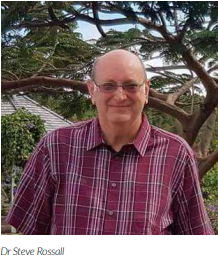
Putting amino acids to the test
Following positive results seen on farms which adopted amino acid biostimulants in 2018, we sought to deepen our understanding of the role of amino acids in plant health and explore the implications of supplementing crops. Enforcing abiotic stress deliberately allows us to really test the physiological implications on the plant and demonstrate how such a product can assist. To explore this in a controlled environment, we called on the expertise of bioscientist Dr. Stephen Rossall from The University of Nottingham. Over several years Steve has looked at a range of foliarapplied biostimulant products on early root and shoot growth. These comprised materials as diverse as: bacterial agents, inorganic molecules, phytohormone products, amino acids and carbohydrates. On the value of biostimulants, Steve had this to say: “When weather patterns are more variable, the need for consistent crop establishment becomes more important. Application of an effective biostimulant can give a yield response in all seasons, but additional benefits may be seen in ‘difficult seasons’ thus providing enhanced yields and more consistency for farmers.”
Our Bridgeway product contains all 18 L-amino acids required to assist with plant functions and healthy development. Steve examined the impact of early applications of Bridgeway on root and shoot growth in both good growing conditions and under various forced stress scenarios. The results of his experiments are extremely encouraging… In the first (non-stressed) experiment, treatments were applied to wheat and spring barley at two concentrations; Bridgeway 1.0 L/ha and Bridgeway 2.0 L/ha. The effects of the treatment were significant, particularly in barley and wheat roots, where the higher concentration saw average dry weights boosted by 41% and 42% respectively. However, it was when the plants were subjected to conditions of abiotic stress that things got really interesting… Steve concentrated on wheat for the stressed experiments, applying Bridgeway at the higher concentration 2.0 L/ha.
Nutrient stress

Steve synthesised nutrient stress by feeding the plants at a 10% rate of the standard feed. Here the Bridgeway made a conspicuous difference, increasing the average dry weight of shoots by 27% and roots by 29%.
Drought stress
In this experiment, wheat was given the standard feed but was subject to irrigation only every fourth day, rather than daily, or when the plants start to show drought symptoms if that occurred earlier. In this instance, Bridgeway made a huge difference, pushing up average dry weight by 24% in shoots and an incredible 48% in roots.
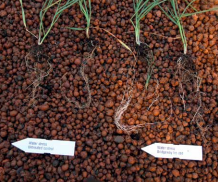
High temperature stress
The results seen here were still more extraordinary. In the heat stress experiment, plants were grown at a constant 30˚C with standard feed and irrigation. The average yield of roots treated with Bridgeway was almost double that of the untreated control at 49%. Shoots saw a boost of 24%.
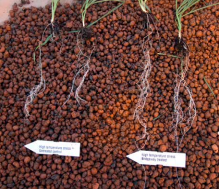
Overall, the biostimulatory effects on early growth were very positive when early applications were made. While there is a clear indication that using Bridgeway stimulated both root and shoot growth, larger effects were consistently observed on root growth. This could be of huge benefit to crops during early establishment. The benefits of applying Bridgeway were most dramatic when the crop was under abiotic stress. Crops typically experience some sort of stress early on, particularly in the spring when soils can be dry and nutrients are locked up. Building structure and root biomass early in the life of the crop will help it be more resilient to environmental stresses and topping up with Bridgeway later in the season will ensure those benefits manifest in the yield.
We were blown away by these results, and excited about what they could mean for the future – particularly if, as predicted, summers like the one seen in 2018 are soon to become the norm. Steve was also pleased with his findings, saying, “I am confident that Bridgeway is in the premier league of the biostimulants I have tested.” His sentiments seem to echo that shared by growers who trialled Bridgeway across a variety of crops last summer.
On the ground
It’s clear that in the right situation, amino acid biostimulants have the potential to add substantial yield and quality benefits.To prove this, we went straight to the source; the growers. From barley to brussels sprouts, Bridgeway has already been used to push performance in a range of crops in stressed and nonstressed on-farm trials. Bridgeway has consistently shown benefits in sugar beet, with yields increasing by up to +11 t/ha; replicated trials in 2018 have shown that three applications of Bridgeway at 2 L/ha produce the very best results. In root crops, Bridgeway increased speed of bulking (+2.2 t/ha per week) and yield (+12.4 t/ha) in potatoes, improving plant health and helping the crop better cope with stress.
Bridgeway also trialled in onions in 2018, where all treatments increased green leaf area, yield per bulb and overall yield. Here, the best results were shown to come from three applications of Bridgeway at 2.0 L/ ha. Three applications of Bridgeway also produced significantly higher yields in winter wheat grown on heavy clay; between +0.84 and 2.21 t/ha when subject to waterlogging, drought or extreme temperature stress. So, the key question; how do amino acids work?
Breathing new life into your plants
Plants require a good amount of certain key amino acids to assist with plant functions and healthy development. Under abiotic stress, for example, plants increase production of L-Proline, strengthening the cell walls and increasing resistance to weather extremes. Plants also rely on L-Glycine and L-Glutamic acid to produce chlorophyll and absorb the light needed for photosynthesis; a plant’s single most important chemical process. Then there’s nutrient uptake. Tiny molecules that can move easily through cell membranes, the amino acids L-Glycine and L-Glutamic acid are able to bond with certain nutrients, making them available to the plant. Their ability to bind excess metals also means they are able to reduce metal toxicity.
Certain amino acids act as precursors to hormones and growth factors; L-Tryptophan is involved in rooting, growth and development; L-Methionine is a precursor to ethylene which stimulates ripening, and L-Arginine is a precursor to cytokinin production involved in cell growth, auxiliary bud growth and leaf senescence. As one of the most critical phases of development, pollination and fruit formation requires high levels of amino acids. L-Histidine helps with ripening; L-Proline increases pollen fertility; L-Lysine, L-Methionine and L-Glutamic Acid increase germination; L-Alanine, L-Valine, and L-Leucine improve fruit/grain quality.
Bridgeway contains the key amino acids in higher concentrations than animal-based amino acids:
• L-Tryptophan (+40%) – fundamental precursor for rooting
• L-Glutamic Acid (+39%) – Stimulates plant development, increases resistance to weather stress. Precursor of other amino acids. Helps adsorption of inorganic N
• L-Aspartic Acid (+46%) – fundamental in metabolic processes and source of N
• L-Serine (+43%) – increased resistance to stress
• L-Lysine (+33%) – fundamental in stimulating photosynthesis
The product also includes organic (ready-to-use source) nitrogen. A major constituent of chlorophyll, nucleic acid (DNA and RNA) and amino acids, nitrogen is arguably the most important nutrient for plant development. Limited nitrogen supply has negative consequences for plants including reduced leaf area, chlorophyll levels, biomass, photosynthetic rate and yield of protein and oils. Transporting nitrogen to newly-developing flowers is a significant determinant for flower set, growth and abortion and is essential for proper development of male and female gametophytes. Since the application of nitrogen fertilisers to crops is limited, the additional boost from Bridgeway will be particularly useful, especially if the crop is deficient.
Recommendations 2019
Biostimulant products like Bridgeway are a valuable tool, helping us protect plants from abiotic stress and reach their full genetic potential in the field. To optimise plant health throughout the life of the crop, we would recommend applying 2.0 L/ha Bridgeway during crop establishment, then a top-up during key stages of development and ahead of any anticipated stress event. To discuss individual scenarios or to request our product, timing and case study guides, please feel free to get in contact with us at info@interagro.co.uk.
-
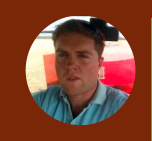
Farmer Focus Update – Alex Shutes
February 2019

Despite not really wanting to start off with the weather it’s had such a significant impact on the farm in the last 12 months that I can’t really avoid it. Despite the late spring/early summer of 2017 being overly dry compared to an ‘average’ (what’s one of those anymore?) year, it turns out that here in Essex, 2018 was even worse for us! Once the ground had dried out enough to get the spring barley and beans in the ground in the 3rd week of April I can recall we had one significant rain event a week or so post drilling and that turned out to be pretty much it until August! An out of action weather station means I haven’t got any exact recorded figures for rainfall in the period but the couple of times we did get something fall out of the sky we were talking 2-3 mm max which just disappeared instantly with the ground being so dry and the temperatures so high.
The Wheat’s looked like they were holding on ok, as was the W Barley and OSR for a considerable time into the drought, a benefit of the strip-till system, until we got to the point where it didn’t matter what establishment system would have been used, any wheat or barley on lighter land really started to suffer very visibly. This was evident come harvest, with one light and gravelly block of 1st wheat that had been looking like it was struggling for weeks yielded approx. 60t off of 40 acres going by the trailer counting method. (Pic below of cutting that Wheat in late July).
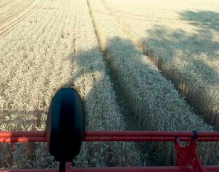
The full toll of the damage on the 1st wheats hasn’t been fully realised yet as it’s still all in the shed due for movement later this year but the heap is not as big as I would like. Kerrin as a 2nd wheat did well for us despite the year with a few light patches pulling down the average but I will take 7.7t/ha in the year we just had. The OSR ironically suffered from wet feet over the winter on about 15 acres of the 70 we planted with next to nothing left growing on that area coming out of winter. We addressed some of the issues with some drainage work in the summer after harvest but the 55 acres we did cut, 3.4t/ha, again not great but it could have been worse.
Bazooka W Barley was disappointing especially for a hybrid but there’s only so much stress these crops can take and a couple of fields suffered from my lack of patience in September 2017 and perhaps weren’t as dry as they could have been when drilled which hampered establishment in places, there is still some crop sold in the shed so final exact yield isn’t known yet but estimating 6t/ha so not very impressive really. The spring crops really suffered compared to the winter crops almost from the day they were drilled, the beans especially which were very short and very few pods come harvest from aborted flowers due to the stress! I won’t shy away from the overall yield as we have to show the bad and the good but I’ll let you work it out, 28t sold off 28ha… no more said.
The spring barley didn’t tiller as it would normally and come harvest the crop had died before even being fully ripe with heads still pointing skywards rather than brackling over as usual but the grain was coming off at 12-13% moisture! Harvest started in the W Barley on the 16th of July, our earliest start since 1976, and we had done everything apart from the spring beans by the 3rd of August. The beans held on until the end of August till they were properly ready to harvest and were dry enough after a few showers but we managed to not have to put a single grain through the grain drier for harvest 2018 which I suppose is one small positive. The new combine for 2018 flew through the crops without a hitch, the addition of the chaff spreader gave visibly better spread of crop residues back onto the stubbles which I believe has helped a lot with the following crops this autumn.
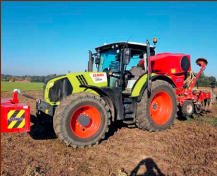
Winter crops for harvest 2019 went in very well with almost perfect sowing conditions for wheat and barley in October 18 and even by late October the couple of fields I delayed drilling due to Blackgrass still went in a treat! The only slight ‘hiccup’ being a complete failure of the front diff on our drilling/spraying tractor whilst out drilling wheat meaning being hauled back to the workshop on the low loader and out of action for a month whilst the work was done to fix it. Luckily Manns sorted us out with another tractor (on the drill in the pic below) to get us going again to finish drilling which was very much appreciated!
Wheat in the 1st wheat slot has been switched from the old timer Claire which has done us well over the years to a new kid on the block called Elicit and is looking good so far (Pic below taken on the 20th of Jan!)

The warmer weather has caused a greater than ideal level of mildew in the KWS Orwell Barley we are growing this year but it’s first dose of N, some Mn through the sprayer (in the pic below on the 14th of Feb) and finally a reasonable rain hopefully will have perked it up a bit though we may go through with a T0 in the coming weeks to keep a lid on disease.
The OSR sown in the 3rd week of August, having waited for it to finally rain and provide enough moisture for establishment, has got away well apart from a few random bare patches which don’t match up with the drill, sprayer or anything so I’m putting it down to slugs though I found very few on the surface. Now into February, its had its first dose of 60 kg/ha of N plus some P, K and S and with the warmer weather its really started to motor on. What I am pleased about is that despite finding the odd flea beetle at night when the crop was at the 2 cotyledon stage I held off spraying and the crop grew past any damage and larvae numbers in the plant now, although some are present, are quite hard to find and don’t seem to be holding the crop back unlike some reports I have heard. I doubt it’s anything I have done specifically, I’ll just put it down to luck!

Cover crops of radish and oats prior to spring crops for 2019 went into ideal conditions in late August and early September and grew very well, they have been destroyed with a pass of Kyleo in mid Jan and for this year we have dropped beans in favour of combinable peas and switched from KWS Irena to RGT Planet for our spring barley. Drilling to commence soon hopefully although I do fear that mother nature will try and makeup for this dry spell we are still in at some point and it will take a considerable amount of rainfall to do so, ditches and ponds that we would normally see with a few feet of water in at this time of year have nothing in at all, something I am told has not been seen before! Could be interesting times ahead and that’s without even mentioning Br…..
-

Drill Manufacturers In Focus…
SPRING HAS BEEN AND GONE ??

Early drilling has been going on thanks to the unseasonably warm weather, winter crops have not really stopped growing and by the look of some local overwintered, cultivated and blackgrass ladened ground, the green hue says that the Blackgrass has not been checked either. There is no doubt that low disturbance drilling into stale seed beds is a useful tool in the fight against blackgrass, as well as delaying drilling for as long as possible in backend, the photo below shows a Ma/Ag drill sowing spring beans (Spring 2018) and it’s quite easy to see that the marker disc is disturbing far more ground than the drills disc coulters, this machine is now working on auto steer, but it shows very clearly the difference.

As with most low disturbance drills, speed also makes a big difference to the amount of soil disturbed, but there is the question of productivity to keep in mind, in order to increase working speed and output but minimise disturbance, the Ma/Ag drill can now be fitted with a press wheel which runs alongside the opening disc which allows faster working speeds while keeping disturbance to a minimum, especially in lighter or loose worked soils.
Add to this the Ma/Ag wide concave rear press wheel which also serves as seed depth control for each coulter, the drills 250kg coulter pressure which allows the drill to work in even the hardest soil conditions, the weight transfer from disc to press wheel gives a firming to the drilled ground and excellent seed to soil contact for quick germination, minimised moisture loss and reduced slug activity.

Another first, last autumn we experimented drilling stubble turnips direct into stubble, as the local farmers attempts 2 weeks earlier in the next door field had been difficult and concerns about moisture loss were severe. Now, said turnips are being eaten, the stubble turnips direct drilled are noticeably larger than those conventionally drilled 2 weeks earlier, less moisture loss, that’s our conclusion.

Direct drilled stubble turnips yield better than those conventionally drill 2 weeks earlier in next door field, is moisture retention the key?
Photos below taken on the same day as direct drilled crop emerged
For more information, contact : Ryetec, 01944 728186
-

An Ongoing Evolution
Written by Mark Atkins of Bio Farming Limited
In 2015 a colleague who operates a company supplying various biological based products into the agricultural market
asked if I could make a product from him as his current supplier was increasing costs that would take it beyond what is
viable for the farmer and agricultural applications. After studying the ingredients and coming to a conclusion that there could be some difficulty, due to a cartel of sorts on some of the ingredients, I declined the request but gave him a sample of a product that is supplied and used in the Sports & Amenity Turfgrass markets since 2007.Having not expecting to hear anything I was somewhat surprised when I was called and asked for a meeting, in which I was informed that the tramline trials, where the product has been applied on various crops has resulted in very significant yields as well as noticeable plant health. That product has now been branded Exalt and instigated the formation of Bio Farming Ltd. Bio Farming Ltd was formed in 2018 that combines the knowledge and experiences of myself, Mark Atkins and Jeremy Hitcham.
Jeremy Hitcham, “I have been in the fertiliser industry all my life. Originally with Bunn Fertiliser for 19 years before the company was sold to Koch Industries, where I stayed on for 6 years eventually leaving to establish my consultancy, Fertiliser Limited. Shortly after I helped with ex colleagues from Bunn to established Payne Crop Nutrition at Fakenham in East Anglia. Later that year Mark and I had the opportunity to create BioFarming Ltd. A concept we had over many years hoped to create into a reality. We believe that many soils have been unknowingly neglected and by utilising a wealth of experience and combinations of our unique products we can make soils perform better”
Mark Atkins, “as a farmer’s son and having spent many long hours working the land and all that comes with the industry, I like to feel that agriculture is in my blood and my feet are in the ground, it certainly feels that way.” My career moved from farming to a spray operator and as an Arable Specialist with Dalgety Agriculture in the south of the country before a shift in to turfgrass production and management, which found me heading to Saudi Arabia for a 3 year stint managing the construction and maintenance of 12 new, one million USD pitches throughout the kingdom, followed by managing a 110 ha turf farm and the first all grass golf course perched in between the wadis and sand dunes 40 miles outside Riyadh with summer temperatures of 45oC plus and winters of -1.

A contract to supply 500,000 m2 (5 hectares) to Dubai, UAE, which was harvested as 20 m2 large rolls and washed with a homemade ‘turf washer’ resulted in the offer to manage the ‘grow-in’ and construction of the Abu Dhabi championship golf course, along with lots of other ‘must do’ items, involved the making a makeshift sprayer from a hydro-seeder tank and pump, a length of scaffolding pipe and irrigation sprinklers to apply some very noxious pesticides and homemade liquid fertilisers! A final move to Dubai in which I introduced an organic granular fertiliser for use on golf & other sports turf facilities before returning to the UK with my family in 2000. A fantastic experience with at times some very difficult growing conditions of brackish saline / sodic soils and questionable recycled irrigation water qualities, extreme temperatures and not to mention all those people I met along the way at work, playing rugby and parties.
Upon my return to the UK I was asked to and undertook the agronomy at various golf course construction projects, which were once again overseas where on making recommendation I was asked if I could supply the ‘specific grades / analysis’ of products as were identified and the fact that none were found in the catalogues of the supply trade companies. One Saturday afternoon at home and alone in the kitchen I blended various powdered mineral fertilisers with zeolites and humic acid. After knocking them about in a drum with some water, screening and then drying the granules in the oven, yes! all windows were wide open, I had produced a granular fertiliser. The then ‘Scotts Company’ based at Howden produced these specific grades on my behalf which were then sold to clients. This was the start of my formulating and trading of bespoke products After many hours of research reading and discussion with others, the vital roles from the myriad of the microbial communities in soils, plants, humans and every living entity was becoming more and more apparent.
With colleagues, a combination of what I call ‘microbial nutriments’ were explored. Initial the product was of individual substances that were tank mixed before application whereas now a days many have been formulation as complexed solutions. The benefits of these was being seen by turfgrass managers on all sports turf surfaces with increased vigour and plant health. In 2007, a Dutch owned UK subsidiary bought my small company as the benefits from their aeration equipment coupled with applications of the ‘microbial nutriments’ were seen as perfect synergy. Research was undertaken at the Royal Holloway College (London University) with a PhD sponsored study on the effects of reducing soil compaction that resulted in the booklet ‘Life Beneath Your Feet’ c/o Charterhouse Turf Machinery Ltd Under the watchful eye of Professor Alan Gange further evaluation was undertaken to quantify the effects of the microbial nutriment on grass plants in as gown on a golf tee.
After what seemed ages of a 6 month period results were issued to great excitement as the applications had increased the root length colonisation (RLC) of ‘mycorrhiza’ from 12.6% to 23.1%. and beneficial bacterial abundance of 71%.

In the words of Professor Gange:- “In mycorrhizal terms, this is a large increase. We would not expect levels to increase to, say, 50% or 60% (i.e. those found in natural grassland) because of the carbon limitation imposed by clipping. Plants fix carbon through the process of photosynthesis and about 20% of the annual fixed C is directed to the roots to feed the mycorrhiza. This is the sole energy source for the fungus. Continuous leaf removal reduces the amount of C fixed and hence limits fungal abundance. Therefore, this product significantly increased the abundance of microbes, both bacterial and fungal, in the soil”.

This product now branded as Concordia has shown that the affect form applications on forage grass product has the ability to increase fresh weight yield by 5.05 tonnes / ha an increase of 33.2% and its dry mater content by 1.49 t/ha or a 45.6% increase. There is now becoming more and more data of the benefits of mycorrhiza for soil and plant health, the sequestration of Carbon Dioxide, efficacies of Nitrogen assimilation and others with subsequent and ongoing benefits. Since then various other substances have been appraised which continue to be applied to some very prestigious sports pitches and other sports turf surfaces (The Emirate Stadium Pitch, Liverpool Anfield Road, Leicester City King Powder Stadium Pitch, Cardiff City Stadium pitch and others).
Plant health and disease In sports turf the number of plant protection products are becoming less available as well as being very costly, where a single application of a fungicide can be between £600 – £1000.00 / hectare ??

With the use of the microbial nutriments, plant health elicitors in combination with precise nutrient applications plant health is improved and the incidence of disease infestation has become almost nonexistent. This means the grass plant, that is constantly under stress from daily mowing, the need to perform, possess high aesthetics and ‘for the game is not compromised from the negatives of disease infection and slow recuperation. The benefits to the clubs are financial, agronomic and environmental as the products are on the whole non-hazardous, being derived from sustainable plant extracts, bespoke and with most being produced in the United Kingdom flexibility, availability and delivery schedules are maintained.
The product range is not large consisting of four categories:
1 Microbial Nutriments and ‘Fertiliser Supplements’
Humic substances, as powder, soluble powder, slow release granular, Liquid Nutrimus and Nutrimus UltraFINE grades These materials are available for direct applications or as supplements to granular and liquid ‘fertilisers’. High values of labile Carbon support microbial communities and help balance Carbon:Nitrogen ratios.
Composition:
Note Table 5 – * Leonardite ranges considerably in humic and fulvic acid content. For example, deposits can have as low as 10% humic acid content and as high as 78%. It’s derived from Lignite based coal and was formed in saltwater deposits. The other 20- 90% of the product that isn’t the active ingredient is made up of ash and heavy metals. The comparison of the two is clearer when you take into consideration the enhanced nutrient quality and properties Nutrimus has over Leonardite shale. Humic substances have been proven to improve the quality of soil, growth of soil organisms, and uptakes of nutrients by plants. The benefits of humic and fulvic substances are well documented.

The direct and compounding benefits where one benefit will lead to the next are:
• mprovement of soil chemistry and structure
• improvement of biological status of soils
• improved utilisation of nutrients supplied and obvious cost savings
• improved water utilisation and possible cost savings
• improved yield – higher income/ha
• improved quality – higher income/ ha
2. Plant and Soil elicitors & enhancers
Exalt
• A complex of 4 Non Hazardous botanical extracts with multifaceted modes of action within the soil, the plant rhizosphere and the growing plant.
• Organic surfactants help to diffuse liquid homogenously into the soil profile
• Microbial nutriments promote a rich biological ‘microbiome’
• Elicitors, promote Systemic Acquired and Induce Resistance, acting similarly as an inoculation, kick starting the plants own immune system
• Naturally occurring synergistic back ground nutrients & amino acids provide nutrition
• Apply Exalt at:
– pre sowing – post germination p
– Exalt can be tank mixed with most liquid nutrients and other compatible products
– Tank mixing with glyphosate and selected herbicides
– Tank mixing with selected fungicides
N.B. That all and every tank mix product should be first tested with a ‘jar tests’ as some adjuvants can be reactive. Exalt contains naturally occurring surfactants and tackifiers.
Application rates: o Cereals & OSR 1.5 – 2 litres / Ha o Root crop (carrots, potato) 2 l/ha o Legumes 1 l/ha
Protos
A liquid EC FERTILISER – PK Fertiliser solution: containing
• Potassium Phosphite 50% Liquid contains a high level of Phosphate at 30% w/w in Phosphite form.
• A very good P-source that also increases general plant vitality and resistance to stress.
• Developed to fertigate in soil grown covered crops and hydroponics as well as for foliar application. Also suitable for dipping plant roots prior to transplanting.
• Transparent liquid solution of high purity
• Improves general plant immune system
• Enhances root growth
Product Characteristics
• Production process certified according to ISO 9001:2015
• Highly concentrated solution
• Low on Sodium and Chloride
• Low on heavy metalsApply at the higher application rate during period of high stress. Tank mix with fungicides to increase efficacies. Apply at 5 – 10 l/Ha
Micronised Mineral Nutrition
• The Parvus product range of micronised mineral nutrients are available as liquids and wettable powders are used extensively for sports turf management, which are now being used in agriculture.
• By micronising mineral elements their ability to be accessed by microbes and assimilated by the growing plant is very evident with plant response to health and subsequent yield increases, higher dry matter content all of which lead to reduced risk of infection, better shelf life and nutrient contents.
• It is not uncommon to attain dry matter contents of perennial ryegrass of >30% with metabolisable energy values (M.E) of 12 – 13 kJ/Kg.
Research and Development
R&D is and will be an ever ongoing process in order to better understand these and now materials to determine application rates, timings & frequencies and also most importantly when not to apply. The evolution of Bio Farming is in real terms just beginning with comprehensive trials to be undertaken this year and as on going to quantify the carryover of benefits for subsequent crops and soil health
Soil Health – the new Muck and Magic’
I know that is this publication the awareness of all matter biological, microbial is well appreciated, yet there is still the belief that all these types of products are ‘muck and magic’ well, that is exactly what it is mother nature working her magic as has always been so.
Cause and Effect
Certainly, in sports turf, the client with whom I work, will ask the question ‘what is the cause of a particular issue and plant condition’ as opposed to reaching for the pesticide bottle.